Israeli fighter jets struck a Hezbollah weapons manufacturing plant in southern Lebanon's Jouaiyya earlier today, the IDF says. A Hezbollah command room and other buildings used by the terror group were struck in Nabatieh, Mansouri, and Kafr Kila, the military adds. Separately, the IDF says a cell of Hezbollah operatives spotted in southern Lebanon's Houla were targeted in an airstrike,. Meanwhile, the military confirms that several drones were launched from Lebanon at northern Israel this afternoon. The IDF says some of the drones were shot down, while others impacted near Kibbutz Ami'ad in the Galilee. Hezbollah took responsibility for the attack, claiming to have targeted an Israeli military site. View Quote English version in second post
|
|
|
"A dying culture invariably exhibits personal rudeness. Bad manners. Lack of consideration for others in minor matters. A loss of politeness, of gentle manners, is more significant than is a riot."
Robert A. Heinlein, Friday |
|
sigh... At this point there's no way this just "ends" and everybody goes back to within their borders. There will be full scale war in the middle east within the next year.
|
|
|
|
 Institute for Study of War Backgrounder 10 Sept Gaza Strip The IDF Air Force struck and killed Hamas fighters in a command-and-control site within a former mosque in Bureij refugee camp on September 10. The IDF conducted drone strikes that killed several prominent fighters in Hamas’ Rafah Brigade, including the commander of the Tal al Sultan Battalion. The six hostages were killed under Hamdan’s command in Tal al Sultan. The same drone strike killed three other company commanders in the Tal al Sultan Battalion, including Nukhba Force company commander Emad Abu Hani, company commander Naeel Bashir, and combat assistance commander Rami Ayash. IDF spokesperson Rear Admiral Daniel Hagari visited on September 10 the tunnel complex in Tal al Sultan where Hamas executed six Israeli hostages. The tunnel was located within one of the largest underground tunnel networks found by the IDF so far. The IDF did not have precise intelligence indicating that Hamas was holding the hostages in this tunnel, but Israeli forces operated ”in a very, very careful manner” in Tal al Sultan due to indications that Israeli hostages were in the area. The hostage Farhan al Qadi rescued on August 27 was in a tunnel less than 700 meters away from where the six hostages were held. The IDF targeted Hamas commanders in a command-and-control compound within the al Mawasi humanitarian zone in Khan Younis, killing the head of Hamas’ aerial system in the Gaza Strip, Samer Ismail Hader Abu Daqa, the head of targeting and surveillance in Hamas’ military intelligence, Osama Tabash, and senior Hamas fighter Ayman Mabhouh. Israeli Defense Minister Yoav Gallant said Hamas is no longer an organized military force in the Gaza Strip, saying that Hamas’ “military formation no longer exists.” Gallant’s comments suggest that IDF operations have disrupted Hamas’ ability to operate as a conventional military. West Bank The IDF resumed Operation Summer Camp in Tulkarm refugee camp on September 10. Israeli Defense Minister Yoav Gallant previously labeled Tulkarm a hub for Palestinian militia activity, adding that Israeli forces must eventually destroy Palestinian militias in the West Bank. Israeli forces conducted overnight raids across the West Bank and detained 16 wanted persons on September 9 and 10. Israeli forces thwarted an attempt to smuggle small arms into the West Bank from Jordan on September 10. Israeli forces detected the smuggling attempt near Naran in the West Bank and recovered four handguns and one shotgun. The IDF concluded its initial investigation into the death of Turkey-born US citizen Aysenur Eygi who was killed near Nablus on September 6. The investigation concluded it is "highly likely" that Eygi was hit "indirectly and unintentionally" by IDF fire. Lebanon Hezbollah conducted ten attacks into northern Israel since CTP-ISW's last data cutoff on September 9. The IDF identified around 45 rockets fired from Lebanon into northern Israel. The Air Force killed a commander from Hezbollah’s Radwan unit in a drone strike in Qaraoun in the Western Beqaa District, Lebanon, on September 10. The commander, Mohammed Qassem al Shaer, “promoted many forms of terrorism" against Israel. Iran and Axis of Resistance US Defense Department Press Secretary Major General Pat Ryder confirmed ongoing US-Iraq Higher Military Commission discussions on the future of the US-led coalition in Iraq during a press briefing but did not comment on reports of the United States and Iraq agreeing to coalition troops withdrawing by the end of 2026. The Houthis claimed on September 10 they intercepted a US MQ-9 Reaper drone over Saada Governorate, Yemen. Houthi spokesperson Yahya Sarea said the Houthis have intercepted nine US MQ-9 Reaper drones since the start of the Israel-Hamas War in October 2023. US Central Command destroyed two Houthi missiles and a Houthi support vehicle in Yemen and a Houthi drone in the Red Sea on September 9. View Quote   
|
|
|
"A dying culture invariably exhibits personal rudeness. Bad manners. Lack of consideration for others in minor matters. A loss of politeness, of gentle manners, is more significant than is a riot."
Robert A. Heinlein, Friday |
|
I agree with Truzman--I don't see Sinwar taking the deal. He already rejected it once about 6 months ago.
Israel proposed giving Hamas leader Yahya Sinwar safe passage out of Gaza in exchange for the group freeing the hostages it holds and giving up control of the strip. "I'm ready to provide safe passage to Sinwar, his family, whoever wants to join him," Israel hostage envoy Gal Hirsch said in an interview Tuesday in the Bloomberg News Washington bureau. "We want the hostages back. We want demilitarization, de-radicalization of course - a new system that will manage Gaza." He reiterated that Israel would also be willing to release prisoners it holds as part of any deal. View Quote
Today (September 10) Muhammad Qassem al-Shaer was eliminated from the air [killed in an air strike]. He was eliminated in the area of Saghbine village north of Lake Qaraoun. Al-Shaer was a commander in the Radwan unit and was involved in activity against Israel and in planning such activity. al-Shaer was born in 1977 and from the Sahmar village in the Western Bekaa. The Radwan unit participates in the shooting attacks against Israel from southern Lebanon (sniping, launching UAVs, firing missiles against tanks, etc.). In our estimation, Radwan operates and tries to maintain its operational readiness for targeted activity inside Israeli territory such as infiltration activity against communities, taking over territory, planting explosives, and the like. View Quote |
|
|
"A dying culture invariably exhibits personal rudeness. Bad manners. Lack of consideration for others in minor matters. A loss of politeness, of gentle manners, is more significant than is a riot."
Robert A. Heinlein, Friday |
Twitter link The commander of Hamas's Tel Sultan Battalion in the Rafah Brigade was killed in an Israeli drone strike several weeks ago. Mahmoud Hamdan was killed alongside three company commanders in the Tel Sultan Battalion, the IDF says. Additional strikes killed several more top commanders in the battalion, along with dozens of operatives. The IDF says Hamdan took a "significant part" in planning the October 7 onslaught, and was involved in other attacks amid the ongoing war. View Quote |
|
|
"A dying culture invariably exhibits personal rudeness. Bad manners. Lack of consideration for others in minor matters. A loss of politeness, of gentle manners, is more significant than is a riot."
Robert A. Heinlein, Friday |
|
Dumb question - I keep hearing about IEDs and RPG attacks on Israeli armor - have they lost any Merkhavas or just the Namer and other lighter stuff?
|
|
|
|
|
Originally Posted By armoredman: Dumb question - I keep hearing about IEDs and RPG attacks on Israeli armor - have they lost any Merkhavas or just the Namer and other lighter stuff? View Quote They claim they've "killed" quite a few, but I've only seen pictures of a couple of tanks damaged badly enough they couldn't drive away. This guy is a Palestinian sympathizer, but he finds lots of video from Telegram. He might have pictures/video. Jon Elmer's X account. |
|
|
"A dying culture invariably exhibits personal rudeness. Bad manners. Lack of consideration for others in minor matters. A loss of politeness, of gentle manners, is more significant than is a riot."
Robert A. Heinlein, Friday |
Two soldiers were killed and several others were wounded after an Israeli Air Force helicopter crashed in the southern Gaza Strip last night, in what the military describes as an accident. According to an initial IAF probe, a UH-60 Black Hawk from the 123rd Squadron had flown to Rafah with a Unit 669 medical team at around 11:30 p.m. to evacuate a seriously wounded combat engineer during fighting in the area. During the final landing stage inside an IDF encampment in Rafah, the helicopter impacted the ground instead of touching down correctly. According to the probe, the helicopter was not hit by enemy fire, and the crash occurred moments before the aircraft was supposed to land, meaning it did not fall from a significant height. The helicopter was still heavily damaged in the crash, and all those aboard it were hurt. In all, two soldiers were killed and another eight were taken to hospitals, including four in serious condition. Among the four seriously wounded is the combat engineer who was injured separately. It is still unclear what led to the crash, although the IAF describes it as an accident. A probe has been launched to determine why the helicopter impacted the ground in the encampment instead of landing correctly. The names of the killed soldiers have not yet been released. View Quote
The IDF releases the names of the two Israeli Air Force soldiers who were killed in the helicopter crash in the southern Gaza Strip early this morning. They are named as Sgt. Maj. (res.) Daniel Alloush, 37, from Tel Aviv, and Sgt. Maj. (res.) Tom Ish-Shalom, 38, from Nes Harim. Both served in the IAF's elite search and rescue Unit 669. Among the seriously wounded in the incident were two pilots and a mechanic with the IAF's 123rd Squadron, a reservist doctor and another soldier with Unit 669. Additionally, a reservist doctor and another mechanic were moderately wounded. Separately, a soldier with the 710th Combat Engineering Battalion was seriously wounded during fighting in Rafah. He was supposed to be evacuated by the Black Hawk that crashed during the landing sequence. View Quote
Overnight, the IDF launched a new raid in the Tubas and Tammun area in the northern West Bank, as part of an ongoing major operation. Amid the operation, the military says a drone strike was carried out against a cell of Palestinian gunmen. The Palestinian Authority health ministry reports five dead in the strike. View Quote |
|
|
"A dying culture invariably exhibits personal rudeness. Bad manners. Lack of consideration for others in minor matters. A loss of politeness, of gentle manners, is more significant than is a riot."
Robert A. Heinlein, Friday |
Another 40 more rockets were launched from Lebanon at northern Israel this evening, bringing the total today to over 100. The IDF says that some 30 rockets were launched at the Arab al-Aramshe area, and another 10 were fired at Matat. Many of the rockets struck open areas, although some impacted Matat. There were no injuries in the attacks. Meanwhile, fighter jets struck Hezbollah sites in southern Lebanon's Khraibeh, as well as a rocket launcher in Ayta ash-Shab, and buildings used by the terror group in Houla, Ayta ash-Shab and Marwahin, the IDF says. View Quote
Two Hamas terrorists who participated in the October 7 onslaught, one of whom was involved in guarding a former slain hostage, were killed in recent airstrikes in the Gaza Strip, the IDF says. Last Wednesday, Abdullah Abu Riala, a member of Hamas's Shati Battalion in Gaza City was killed in a drone strike. The IDF says Abu Riala participated in the October 7 massacre and was later among those responsible for guarding Cpl. Noa Marciano in Gaza. Marciano, who was abducted on October 7, was later killed by Hamas at Shifa Hospital. Her body was recovered by the IDF in November. A separate drone strike killed Ayman Khaled Ahmed Abu al-Yahni, who the IDF says was a member of Hamas's elite Nukhba force and was involved in attacking the Erez Crossing during the October 7 onslaught. View Quote
The Shati battalion was mostly defeated early in the war. This illustrates how key parts of it went to ground and continued to hide out for 11 months. This is one way Hamas continues to have influence and control and apparently to rebuild on some areas. It’s good news to find them, it’s concerning how parts of Hamas command and control continue to exist or return to areas. View Quote
Defense Minister Yoav Gallant reveals a document he says was written by the former commander of Hamas’s Khan Younis Brigade, Rafa’a Salameh, and addressed to Hamas leader Yahya Sinwar and his brother Muhammad, in which the commander describes the "difficult situation" the terror group is in. "Please consider the following: We maintain the remaining weapons and equipment, as we have lost 90-95% of our rocket capabilities; and we have lost some 60% of our personal weapons; we have lost at least 65-70% of our anti-tank launchers and rockets, and most importantly that we have lost at least 50% of our fighters between those who are martyred and wounded, and now we are left with 25%. The last 25% of our people have reached a situation where the people do not tolerate them any more, broken on a mental or physical level," the document says, according to excerpts provided and translated by the Defense Ministry. Gallant says the document shows "a real hardship that affects Hamas and affects the most senior commanders." He says Salameh, who was killed in an IDF strike in July, "cries out for the help of the Sinwar brothers, but of course they cannot save him." "Why? Because we are continuing the effort that started in October and continues step by step... and reaches all senior Hamas officials. He wrote this to the Sinwar brothers, we will get to them as well," Gallant says. Yahya Sinwar is the leader of Hamas in Gaza, and was recently appointed as the head of the terror group following the assassination of Ismail Haniyeh. Muhammad is a senior commander in Hamas's military wing. View Quote
The Imam Ali Garrison Missile Silo Base outside Khorramabad. In this underground complex of the Revolutionary Guards can be found 8 tunnels and two launch shafts from inside the mountains. In addition, the base consists of pads for mobile ballistic missile launchers, air defense positions, storage bunkers, and an operational headquarters. The base is 1,265 kilometers from the center of Israel. We identified several types of missiles, including the Shahab-3, which has a range of 1,300 kilometers and can carry 800 to 1200 kilograms of explosives. View Quote
|
|
|
"A dying culture invariably exhibits personal rudeness. Bad manners. Lack of consideration for others in minor matters. A loss of politeness, of gentle manners, is more significant than is a riot."
Robert A. Heinlein, Friday |
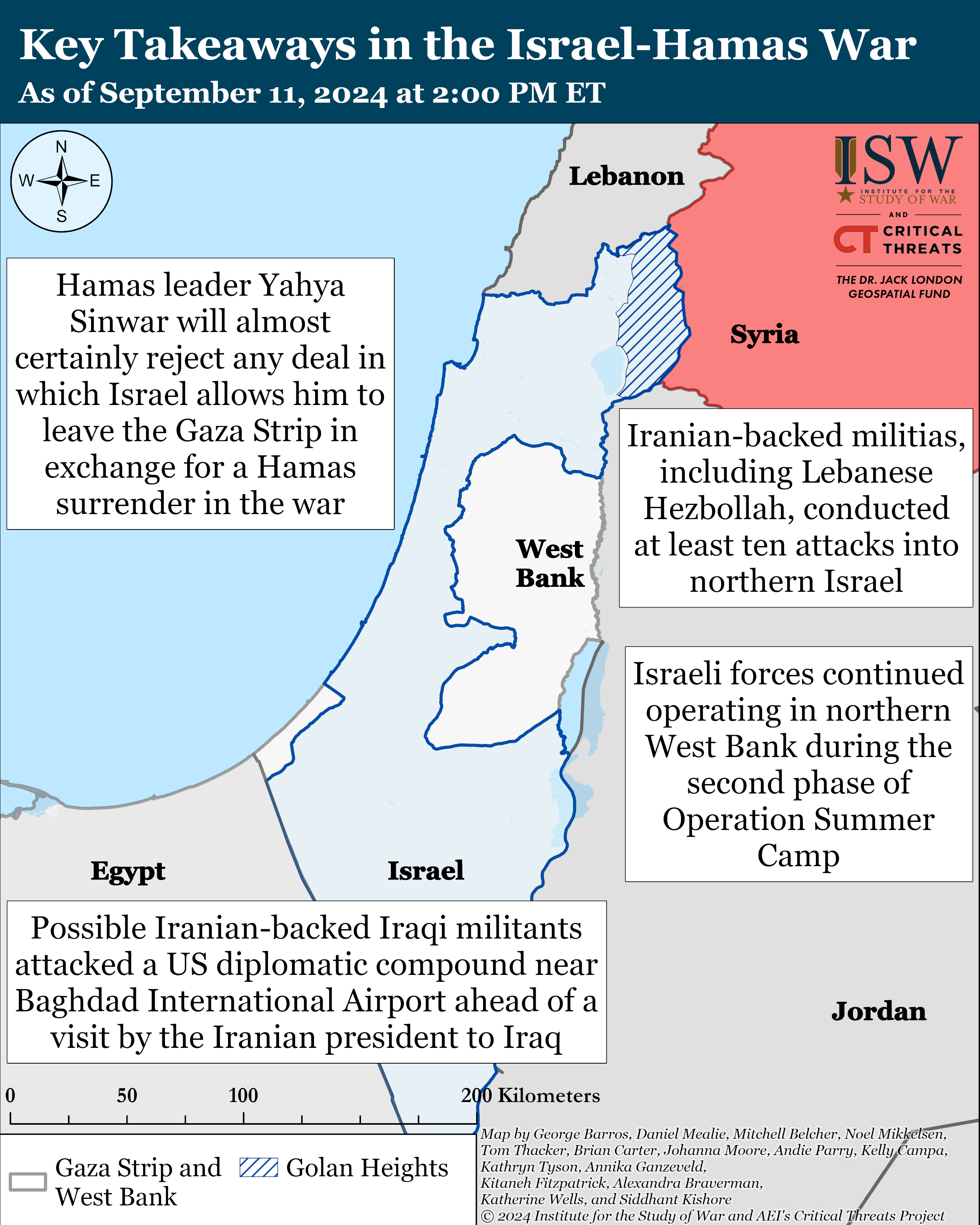 Institute for Study of War Backgrounder 11 Sept Gaza Strip The IDF Southern Command’s fire control commander said that Hamas no longer functions as a conventional military organization but added that the IDF requires another year to fully destroy Hamas’ military and governance capabilities. He said that within a year he expects that the IDF would have "complete freedom of action” in the Gaza Strip. The commander also said he believes it is possible to degrade Hamas to an extent it can never recover. A Palestinian journalist reported that the IDF partially withdrew from southern Zaytoun on September 11. IDF last confirmed its forces operated in Zaytoun on September 9 to Palestinian Islamic Jihad (PIJ) targeted Israeli armor with a previously planted improvised explosive device (IED) on the northeastern end of the Netzarim Corridor.[46] PIJ posted the claim on September 11 after it “restored contact” with its fighters from the Shujaiya neighborhood. The IDF Air Force struck and killed Hamas fighters in a command-and-control complex within a former school in Nuseirat refugee camp in the central Gaza Strip on September 11. The IDF Air Force struck the al Jaouni school complex that it said Hamas had built into a command center. The Gaza Strip Civil Defense Spokesperson said that the IDF has struck al Jaouni school five times since February 2024. Palestinian sources said that the strike killed at least 16 Palestinians and wounded 18 others. An IDF helicopter crashed while landing in Rafah, killing two IDF soldiers. 123rd Helicopter Squadron's UH-60 Blackhawk was landing in Rafah to conduct a medevac. The IDF is investigating the incident but confirmed that the incident was not caused by “enemy fire.” IDF killed two Hamas fighters in airstrikes over the past week who participated in the October 7 attacks on Israel. One of the fighters was from the Hamas al Shati Battalion and helped guard an IDF hostage at al Shifa Hospital; the other was a member of Hamas’ special operations force that attacked the Erez crossing area on October 7. Hamas met with the Democratic Front for the Liberation of Palestine (DFLP) in the Gaza Strip to discuss ceasefire-hostage negotiation and post-war governance. The DFLP has actively supported Hamas operations in the Gaza Strip since October 2023. Humanitarian aid groups continued a second day of polio vaccinations in the northern Gaza Strip in the final phase of the UN polio vaccination campaign. Hamas information captured and released by Israel supports the assertion that the IDF has severely degraded Hamas’ military capabilities. Gallant released a captured Hamas letter on September 11 authored by Hamas Khan Younis Brigade Commander Rafe Salamah in which Salamah told Hamas leader Yahya Sinwar of the damage sustained by the Khan Younis Brigade. Salamah wrote the letter at an unspecified point before his death in July 2024. Salamah told Sinwar that his brigade had lost 50% of its fighters and that another 25% of the remaining fighters were mentally or physically unfit to fight. Salamah added the brigade had depleted or lost control over 60% of its small arms and at least 65-70% of its anti-tank weapons. Hamas leader Yahya Sinwar will almost certainly reject a deal for his safety in exchange for Hamas surrender. Israeli hostage coordinator Gal Hirsch told Bloomberg News that he extended an offer to Hamas on September 8 that would give Sinwar free passage from the Gaza Strip in exchange for the return of the hostages, demilitarization, de-radicalization and a new political system in the Gaza Strip. These stipulations would achieve all Israeli war aims in the Gaza Strip and result in a Hamas surrender. There have been no indications that Sinwar would moderate his stance to protect his own life. West Bank Israeli forces engaged Palestinian fighters in five locations across the West Bank since CTP-ISW's last data cutoff on September 10. Israeli forces continued operations in Tulkarm, Tammun, and Tubas on September 11 as part of a major IDF operation designed to degrade Palestinian militia networks in the West Bank. These operations are continuation of Operation Summer Camp, which began on August 27 in Jenin. The IDF detained 23 wanted persons across the West Bank since CTP-ISW's last data cutoff on September 10. A 58-year-old Palestinian used a fuel tanker to ram an IDF checkpoint at Givat Assaf junction in the West Bank, killing one soldier.on September 11. Israeli security forces shot and killed the driver. The IDF identified the attacker as a resident of Rafat, West Bank. Lebanon Iranian-backed militias, including Lebanese Hezbollah conducted ten attacks on northern Israel since CTP-ISW's last data cutoff on September 10. Hezbollah fired anti-tank guided missiles at an Israeli position near Dan, injuring one IDF soldier. The Air Force conducted airstrikes targeting 30 Hezbollah rocket launchers and military infrastructure in four areas in southern Lebanon on September 10. The Treasury Department sanctioned three individuals, five companies, and two vessels responsible for facilitating illicit oil and liquefied petroleum gas shipments to the Syrian government and channeling the profits to Hezbollah. Iran and Axis of Resistance Senior Iranian military officials opened a new IRGC Ground Forces aviation base in West Azerbaijan Province, Iran that could help the IRGC Ground Forces address perceived threats from external Kurdish opposition groups and respond to internal security issues in Kurdish areas of Iran. This new base, which is in Oroumiyeh, West Azerbaijan Province, close to the border with Turkey, will operate under the Hamzeh Seyyed ol Shohada Operational Base responsible for West Azerbaijan and Kurdistan Provinces. Khatam ol Anbia Central Headquarters Inspection Deputy Brigadier General Mohammad Jafar Asadi claimed that Israel’s recent airstrikes in Syria “will not go unanswered” during an interview with Iranian media on September 11. US Central Command destroyed five Houthi drones and two Houthi missiles in Houthi-controlled areas of Yemen on September 10. View Quote 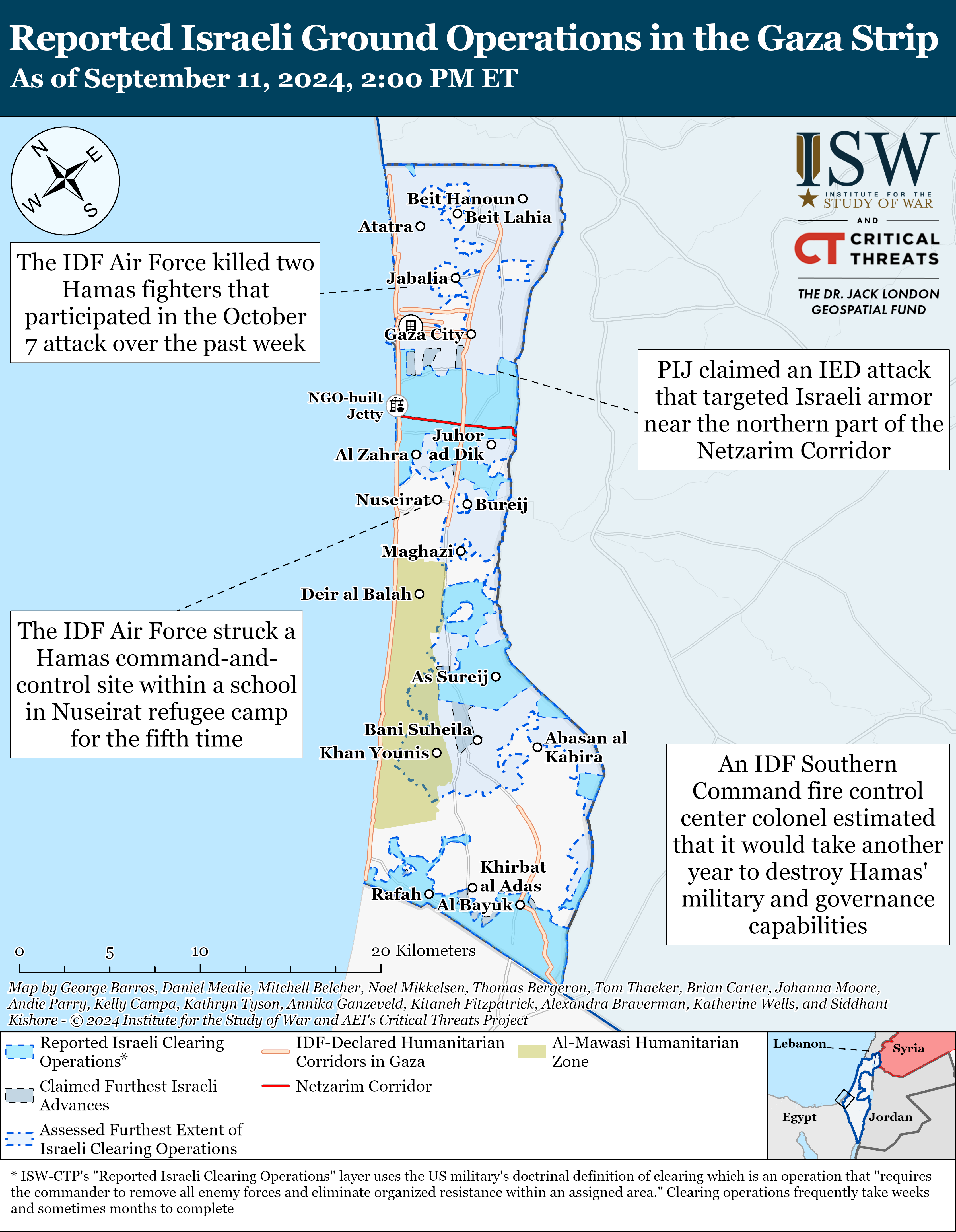  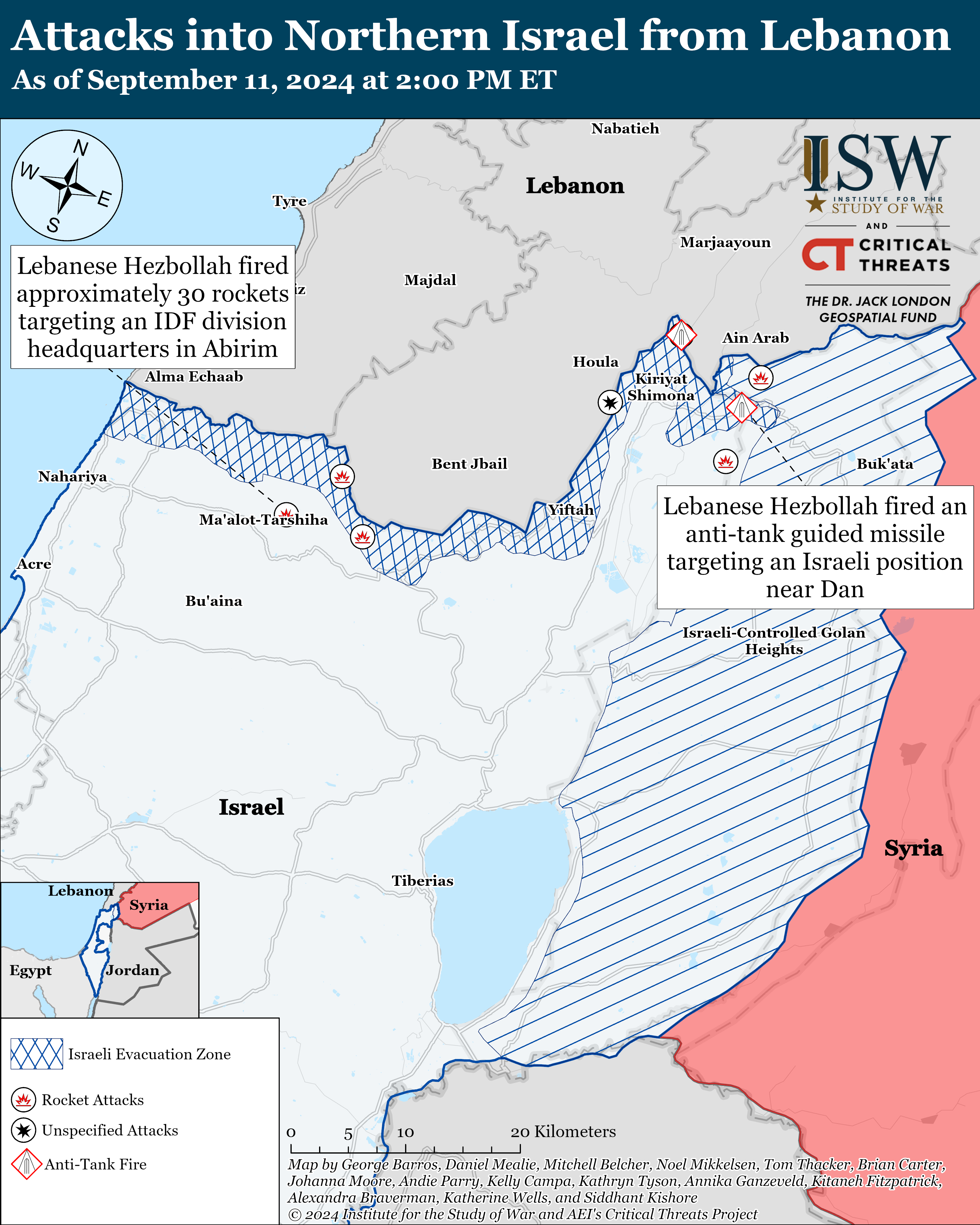
|
|
|
"A dying culture invariably exhibits personal rudeness. Bad manners. Lack of consideration for others in minor matters. A loss of politeness, of gentle manners, is more significant than is a riot."
Robert A. Heinlein, Friday |
|
Nice secondaries in video
Another 40 more rockets were launched from Lebanon at northern Israel this evening, bringing the total today to over 100. The IDF says that some 30 rockets were launched at the Arab al-Aramshe area, and another 10 were fired at Matat. Many of the rockets struck open areas, although some impacted Matat. There were no injuries in the attacks. Meanwhile, fighter jets struck Hezbollah sites in southern Lebanon's Khraibeh, as well as a rocket launcher in Ayta ash-Shab, and buildings used by the terror group in Houla, Ayta ash-Shab and Marwahin, the IDF says. View Quote
Overnight, Israeli security forces arrested a wanted Palestinian from a hospital in the southern West Bank city of Halhul, who had been wounded in an attempted car bombing attack last month. Members of police's elite Yamam unit and Shin Bet agents raided the hospital near Hebron overnight in a joint operation with the IDF. The Shin Bet says that the detained suspect was involved in a car bomb that detonated in Halhul on August 13, in which he was also injured. He was taken to a hospital in the city where he was then detained. View Quote
|
|
|
"A dying culture invariably exhibits personal rudeness. Bad manners. Lack of consideration for others in minor matters. A loss of politeness, of gentle manners, is more significant than is a riot."
Robert A. Heinlein, Friday |
|
Twitter thread about IDF attack/raid on Syria last week. First tweet below, thread in quote box:
Last Thursday night, around 11:00, residents of western and central Syria heard the sounds of a large number of huge explosions in the direction of the Masyaf area near the Syrian-Lebanese border. These explosions were not the only thing that happened in Masyaf this evening. Α security source confirmed to me that last Thursday evening, special forces from the |#IDF carried out a special operation against a military facility belonging to the IRGC, six kilometers southwest of the Syrian city of Masyaf. The operation began with an air strike targeting a number of roads leading to the military facility, in addition to a headquarters affiliated with the Syrian military security and the facility’s security points. Then, Israeli military helicopters carrying Israeli special forces moved towards the facility, supported by combat helicopters and drones, to prevent any forces from the Assad regime from reaching the area. The operation lasted for about an hour, during which the Israeli special forces were able to enter the facility, withdraw important equipment and documents, mine the facility from the inside, then destroy it and withdraw under air cover through fire belts surrounding the site, to prevent any air movements by Assad's warplanes. The targeted facility is directly affiliated with the IRGC and is responsible for developing ballistic missiles and drones and provides logistical support to the Hezbollah militia in #Lebanon. The facility has been operating for more than ten years and was subjected to Israeli air strikes last year. This special operation in Syria is considered an important development in the recently escalating scene in the Middle East. It is certain that what happened in Masyaf will become more clear in detail as the days pass and may be an indication of the imminence of a new escalation, whether on the Syrian or Lebanese arena. View Quote
In a rare admission, the IDF says it carried out two drone strikes in southern Syria today, targeting a Hezbollah operative and another Iran-linked terrorist. The military says the first strike, in the Quneitra area killed Ahmed al-Jaber, a member of Hezbollah's so-called Golan File unit. Another strike, in the al-Rafid area, targeted a "terrorist who advanced terror acts against the State of Israel, and acted with the cooperation and direction of Iran." the IDF says. Meanwhile, the military says several explosive-laden drones were launched from Lebanon at northern Israel earlier today, impacting near the Keren Naftali area. Earlier today, some 15 rockets were fired from Lebanon at the Western Galilee. There were no injuries in the attacks. View Quote
After UNRWA said six staffers were killed in an IDF strike yesterday on a school in the central Gaza Strip, the military names nine Hamas operatives killed in the attack, including some who were also employed by the UN Palestinian refugee agency. The IDF had said yesterday that it struck a Hamas command room in the Al-Jaouni School in Nuseirat, and took steps to mitigate civilian harm. Hospital officials in Gaza reported 14 dead, and UNRWA later said six were members of the agency. The military says that "upon receiving the allegation that local Palestinian workers of the UNRWA agency were killed in the strike, the IDF contacted the agency yesterday for details and names in order to examine the allegation in depth and as of this writing it has not yet been answered despite repeated requests." So far, the IDF says it has identified nine Hamas operatives killed in the strike, three of whom were also UNRWA staffers. They are named by the IDF as Ayser Qardaya, a member of Hamas's internal security force; Muhammad Adnan Abu Zaid, a members of Hamas's military wing who launched mortars at troops, and a UNRWA staffer; Bassem Majed Shahin, the commander of a Hamas military wing cell, who participated in the October 7 onslaught; Omar al-Judaili, a member of Hamas's military wing and internal security force; Akram Saber al-Ghalidi, a member of Hamas's military wing and internal security force; Muhammad Issa Abu al-Amir, a member of Hamas's military wing who participated in the October 7 onslaught; Sharif Salam, a member of Hamas's military wing; Yasser Ibrahim Abu Sharar, a member of Hamas's military wing and emergency committee in Nuseirat, as well as a UNRWA staffer; and Iyad Matar, a member of Hamas's military wing and a UNRWA staffer. View Quote |
|
|
"A dying culture invariably exhibits personal rudeness. Bad manners. Lack of consideration for others in minor matters. A loss of politeness, of gentle manners, is more significant than is a riot."
Robert A. Heinlein, Friday |
|
More details about the Israeli raid in Syria.
Israeli Commandos Carried Out Raid on Secret Weapons Site in Syria. Link to NYT article Highpoints Initial airstrikes destroyed at least four Syrian military positions around Masyaf, including an air defense site. A second round of strikes hit a building in the complex that connects to underground tunnels. In the operation’s third phase, helicopters crossed into Syrian airspace and dropped off several dozen Israeli commandos on the outskirts of the bunkers. As the Israeli soldiers advanced on the bunkers, Israeli drones attacked Syrian military troops who were rushing to the scene, he said. The main goal of the ground assault was to destroy the facility. An important secondary objective, officials said, was to collect intelligence about Hezbollah’s weapons development. Qassim Suleimani...urged President Bashar al-Assad of Syria to allow Iranian scientists to refurbish the weapons labs at the site, which had become a key missile and munitions manufacturing facility for Hezbollah. The facility has, in the past, been associated with chemical weapons production, there was no such work being done there in recent years. Currenly the facility was making precision-guided missiles for Hezbollah [that] would allow the group to strike targets more accurately in northern Israel. View Quote Entire article The missile production facility was destroyed in the attack, according to Western officials. Syrian state media reported that 18 people were killed in the strike. Israel carried out a commando raid in Syria on Sunday that obliterated a Hezbollah missile production facility near the Lebanese border, killing a number of people at the site, according to American and other Western officials. The operation included a daring raid by Israeli special forces, who rappelled down from helicopters and apparently seized materials from the missile facility, the officials said. Ground forces were used in the attack because of its complexity and to recover information from the secret weapons site, the officials said, adding that there were no Israeli casualties. The officials said the raid included airstrikes on the sprawling site, the Scientific Studies and Research Center, which is near Masyaf, in the country’s northwest. Syria’s state news agency, SANA, reported on Monday that 18 people were killed and dozens more injured. The Syrian Observatory for Human Rights, a group based in Britain that tracks the conflict in Syria, said the strikes hit an area containing a scientific research institute where work on developing short- and medium-range precision missiles is conducted. Israel has declined to comment on the raid. Before conducting the strike, Israel notified senior American officials, including Gen. Michael E. Kurilla, the head of United States Central Command, according to a U.S. official. On Sunday, General Kurilla visited the underground war room of the Israel Defense Forces’ Northern Command, where he was presented with the military’s operational plans for Lebanon, according to the Israel Defense Forces. Independent experts, Israeli officials and the U.S. government have described the institute in Syria as a center of weapons research and development, aided by the country’s ally Iran. Israel has struck Masyaf, about 25 miles from the Mediterranean coast, several times in the past. In 2018, Israel assassinated a Syrian scientist who worked at the facility developing precision-guided munitions. In fact, Israel has been gunning for the facility for many years, according to a former senior Israeli official who still advises the government and is familiar with Israeli efforts to neutralize the site. Chemical weapons were developed there before Syria’s civil war began in 2011. Years later, he said, Gen. Qassim Suleimani, who was leading Iranian foreign operations, urged President Bashar al-Assad of Syria to allow Iranian scientists to refurbish the weapons labs at the site, which had become a key missile and munitions manufacturing facility for Hezbollah. Israeli officials believe that Hezbollah wanted the facility to be in Syria because its leaders thought Israel would be less likely to strike Masyaf than sites in Lebanon. One of the Western officials said Israel had attacked the facility several times but could not reach the fortified inner rooms with airstrikes alone. The decision to send in commandos, he said, was to make sure that this time, the site would be destroyed. The airstrikes late Sunday and early Monday amounted to one of the deadliest attacks in Syria in months. SANA said that in addition to the 18 dead, 37 people were injured in the strikes, including six who were in critical condition. The agency said that roads and water, power and telephone infrastructure were damaged. Although the facility has, in the past, been associated with chemical weapons production, there was no such work being done there in recent years, officials said. But the facility was making precision-guided missiles for Hezbollah, which some government analysts feared would allow the group to strike targets more accurately in northern Israel. Writing in the “Syria Weekly” Substack, Charles Lister, the director of the Middle East Institute’s Syria and counterterrorism programs, offered more details about the Israeli operation. Mr. Lister said that an initial round of Israeli airstrikes destroyed at least four Syrian military positions around Masyaf, including an air defense site. A second round of strikes hit a building in the complex that connects to underground tunnels, he said. In the operation’s third phase, Mr. Lister said, several Israeli helicopters crossed into Syrian airspace and dropped off several dozen Israeli commandos on the outskirts of the bunkers. As the Israeli soldiers advanced on the bunkers, Israeli drones attacked Syrian military troops who were rushing to the scene, he said. Officials briefed on the operation said the main goal of the ground assault was to destroy the facility. An important secondary objective, officials said, was to collect intelligence about Hezbollah’s weapons development. Mr. Lister said the facilities in Masyaf and in the neighboring town of Mahruseh have been central to Syria’s development of ballistic missiles, cruise missiles, barrel bombs and thermobaric munitions, weapons with special explosive mixtures typically used to destroy buildings and tunnels. Helene Cooper is a Pentagon correspondent. She was previously an editor, diplomatic correspondent and White House correspondent. More about Helene Cooper Eric Schmitt is a national security correspondent for The Times, focusing on U.S. military affairs and counterterrorism issues overseas, topics he has reported on for more than three decades. More about Eric Schmitt Julian E. Barnes covers the U.S. intelligence agencies and international security matters for The Times. He has written about security issues for more than two decades. More about Julian E. Barnes Ronen Bergman is a staff writer for The New York Times Magazine, based in Tel Aviv. His latest book is “Rise and Kill First: The Secret History of Israel’s Targeted Assassinations,” published by Random House. More about Ronen Bergman See more on: Hezbollah View Quote |
|
|
"A dying culture invariably exhibits personal rudeness. Bad manners. Lack of consideration for others in minor matters. A loss of politeness, of gentle manners, is more significant than is a riot."
Robert A. Heinlein, Friday |
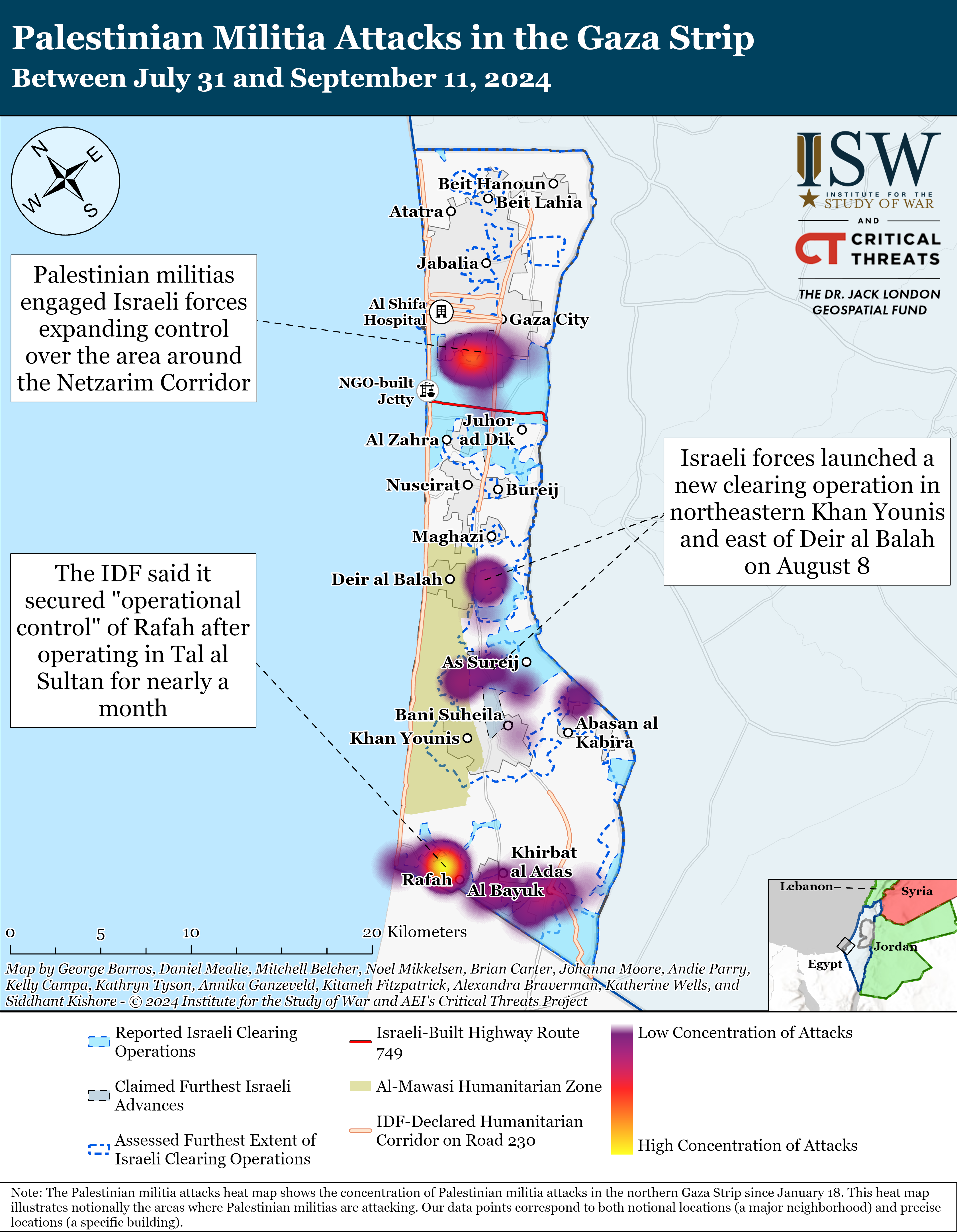 Institute for Study of War Backgrounder 12 Sept Gaza The United Nations Relief and Works Agency for Palestine Refugees in the Near East (UNRWA) said Israeli airstrikes killed six UNRWA employees in the central Gaza Strip on September 11. The IDF conducted two airstrikes on September 11 on a Hamas headquarters in al Jaouni school in the Nuseirat refugee camp. UNRWA the airstrikes caused the “highest death toll among our staff in a single incident.” The IDF reported that it killed nine Hamas fighters, three of whom the IDF said worked for UNRWA while they were members of Hamas. Hamas’ recent attack rate and type in Rafah indicate that the Rafah Brigade is severely degraded and is no longer operating as an effective military unit. The weekly rate of Hamas attacks in Rafah has steadily declined since the IDF went into Rafah in May 2024. The IDF stated that it has also killed at least 2,308 Hamas fighters in the Rafah Brigade and destroyed 13 kilometers of tunnels since beginning clearing operations in Rafah in May 2024. An Israeli military correspondent reported that the IDF can destroy the remaining tunnels under Rafah in three weeks. 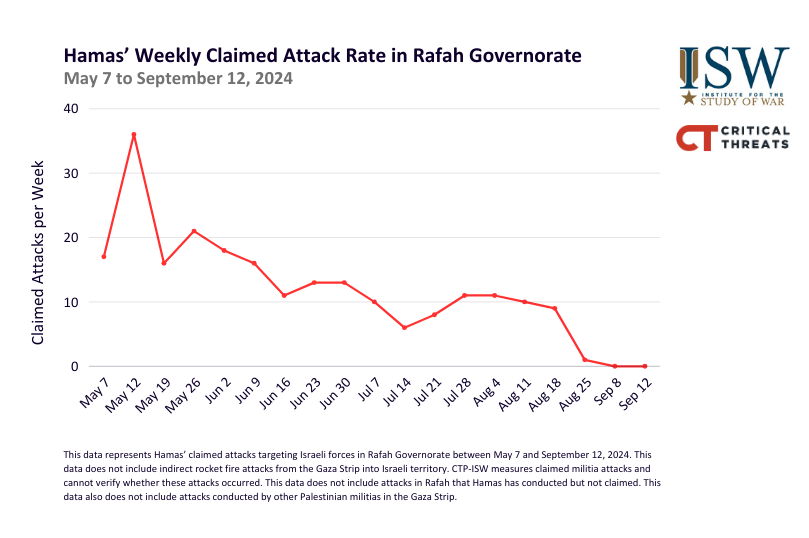 Smaller Palestinian militias allied with Hamas have continued to target Israeli forces in the area, however, and can continue to threaten Israeli forces along the Philadelphi Corridor, even if Hamas is severely degraded. The IDF stated that it has located and destroyed most of the underground tunnels below the Philadelphi Corridor.[23] Cohen said that Israeli engineering forces recently located 203 interconnected tunnels near or under the Philadelphi Corridor. The IDF stated it has already destroyed 80 percent of the tunnels and intends to scan and demolish the remaining 20 percent. IDF sources told Israeli media that Hamas did not primarily use underground tunnels for smuggling weapons into the Gaza Strip from Egypt. The IDF identified nine tunnels that crossed into Egyptian territory from Rafah. Cohen confirmed that all nine tunnels were inactive and had been previously blocked by Egyptian authorities or Hamas. IDF sources told the Jerusalem Post that most weapons in Hamas’ stockpiles are believed to have been smuggled aboveground through the Rafah border crossing, which is controlled by Egypt. Most of Hamas’ aboveground and underground smuggling operations occurred during Mohammad Morsi’s one-year term as president of Egypt from 2012 to 2013. Hamas’ main goal along the Philadelphi Corridor was to store and fire long-range rockets.[31] The sources said that Rafah, and the Philadelphi Corridor in particular, contained one of Hamas’ largest long-range rocket arsenals found by the IDF during the war. A Hamas delegation met Egyptian and Qatari mediators in Doha to discuss the ceasefire-hostage negotiations with Israel, specifically the release of Palestinian prisoners. Khalil al Hayya led the Hamas delegation that met with Egyptian General Intelligence Services Director Abbas Kamel and Qatari Prime Minister Mohammad bin Abdulrahman al Thani. Kamel and Thani reportedly encouraged Hayya to “lessen” Hamas’ demand for the release of 100 Palestinian prisoners serving life sentences in Israeli prisons. The commander of the IDF 162nd Division, Brigadier General Itzhak Cohen, announced on September 12 that the IDF has “dismantled” Hamas' Rafah Brigade and secured control of the urban Rafah City area after four months of operations there. West Bank Israeli forces withdrew from Tulkarm on September 12 after operating there for the last three days as part of a major IDF operation designed to degrade Palestinian militia networks in the northern West Bank. Israeli forces conducted a drone strike killing three senior Palestinian Islamic Jihad (PIJ) members in Tulkarm on September 11. Israeli forces detained a wanted individual, who was under investigation for an attempted bombing attack, from a hospital in Hebron Governorate on September 12. He has sustained injuries after accidentally detonating an explosive device in a vehicle while transferring the “bomb” from “one location to another.” Lebanon The IDF conducted an airstrike targeting at least two actors tied to Lebanese Hezbollah and Iran in southern Syria on September 12. The IDF struck and killed Lebanese Hezbollah fighter Ahmed al Jaber in a car near the town of Khan Arnabah in Quneitra Province. The IDF separately struck an unidentified militia fighter near Rafid on the Israel-Syria border. The IDF claimed that the fighter had promoted attacks against Israel and acted with “Iranian cooperation and guidance.” Iran and the Axis of Resistance An anonymous Iranian-backed source claimed that Iranian-backed Iraqi militias were not responsible for the attack on a US diplomatic compound near Baghdad International Airport on September 10. CENTCOM destroyed a Houthi drone in a Houthi-controlled area of Yemen on September 11. IDF raid on Syria Israeli special operations forces conducted a highly unusual raid into Syria on September 8 to destroy a major Iranian-backed precision missile factory and recover intelligence from the site. The mission targeted the Syrian Scientific Studies and Research Center (SSRC) site in Masyaf in northwestern Syria, which has been long involved in the production of advanced weapons, including precision munitions. The Israeli raid began with several airstrikes targeting nearby roads in order to isolate the facility and prevent Iranian-backed or Syrian reinforcements from arriving. Israeli SOF entered the facility, some of which was underground, and engaged Syrian guards. The Israeli SOF then planted explosives before leaving the facility and detonated them remotely. The explosives were needed to destroy the facility because it was underground and thus protected from airstrikes. Israeli SOF sustained no reports casualties during the raid. Iran built the targeted site in 2018, and Lebanese Hezbollah has used it since then to produce weapons. The raid was part of a concerted Israeli effort to disrupt Iranian weapons supply networks in the Levant. The Israel Defense Forces (IDF) have conducted numerous airstrikes across Syria to this end in recent months, including the strike that killed several senior IRGC officers in Damascus in April 2024. View Quote 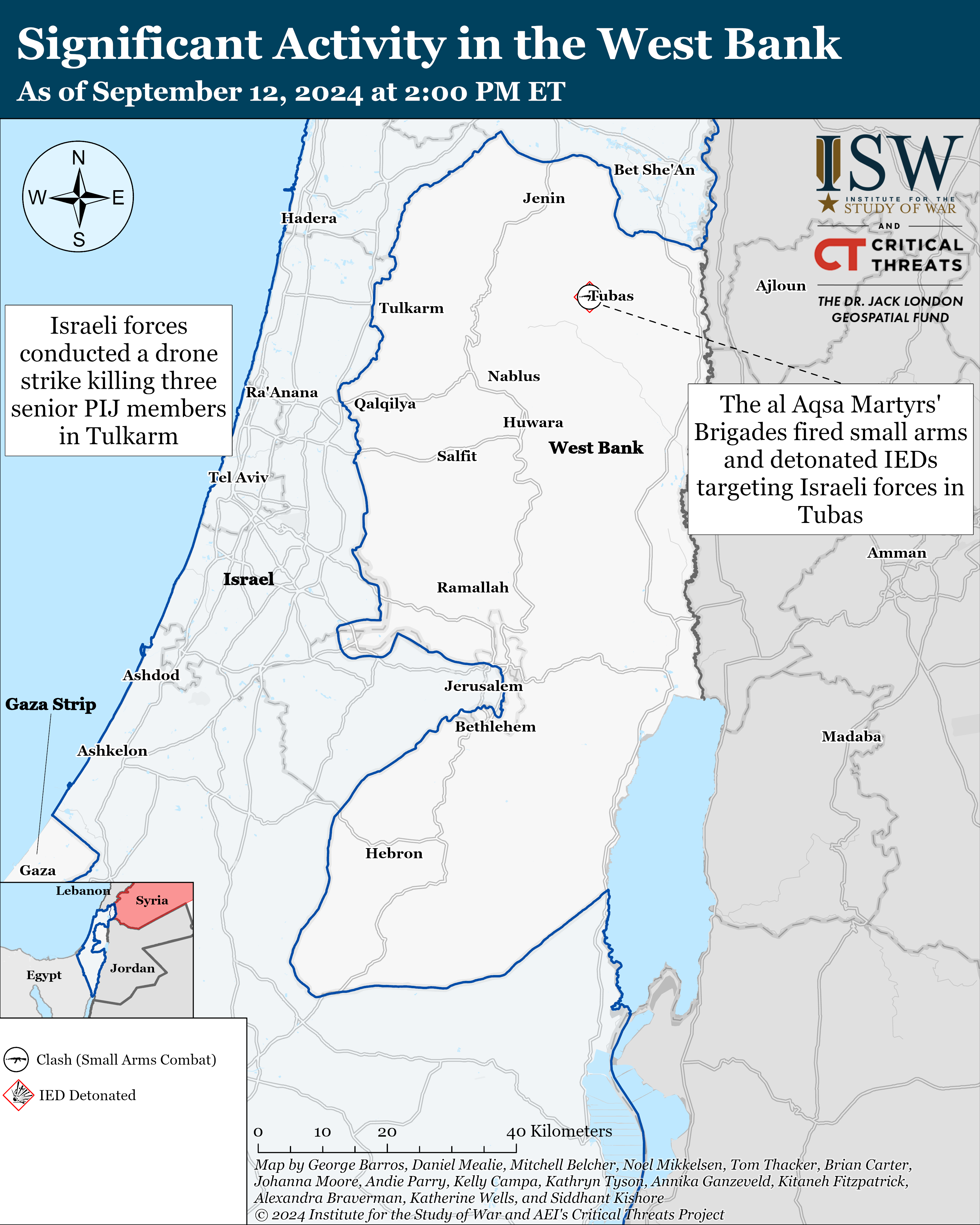 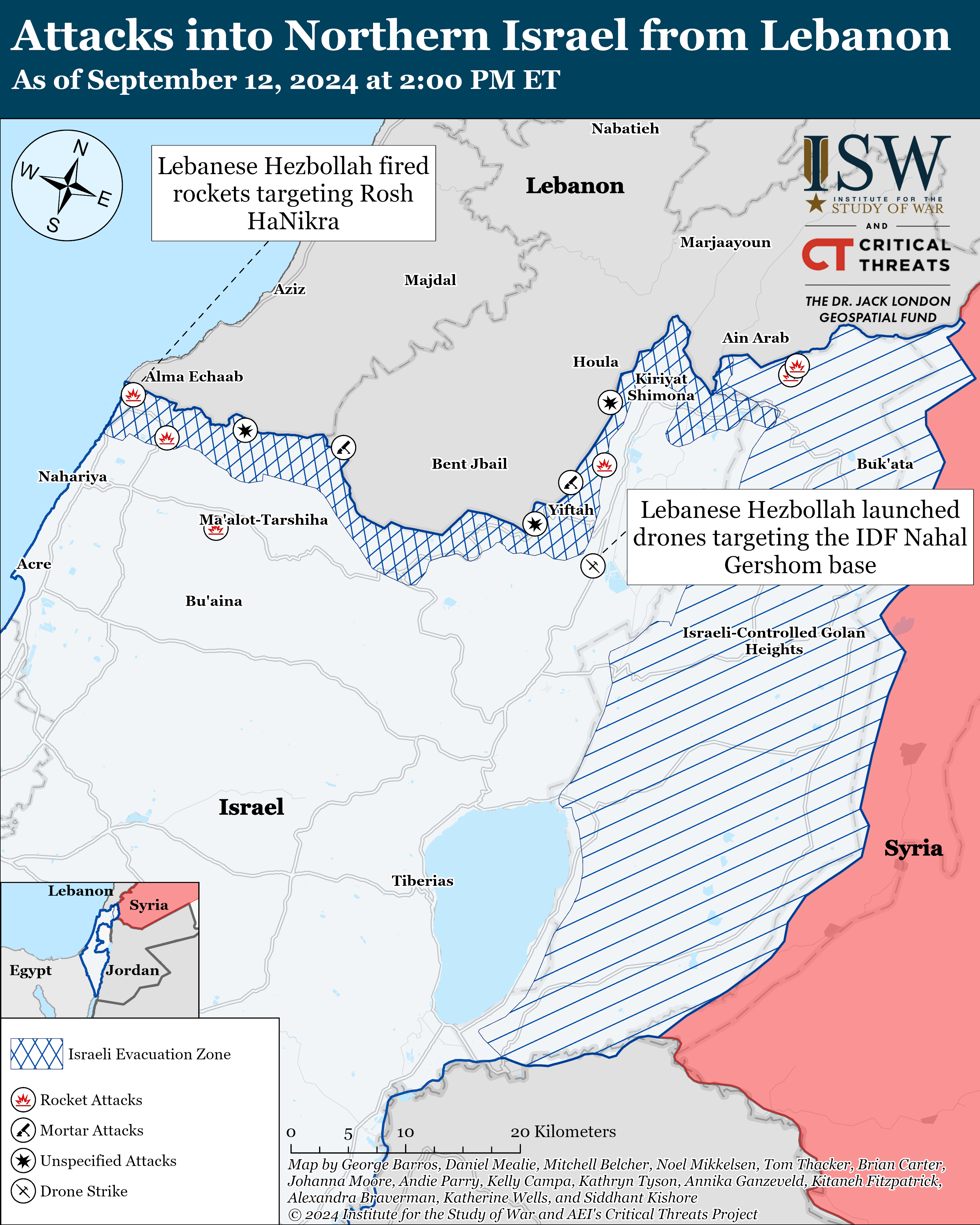
|
|
|
"A dying culture invariably exhibits personal rudeness. Bad manners. Lack of consideration for others in minor matters. A loss of politeness, of gentle manners, is more significant than is a riot."
Robert A. Heinlein, Friday |
|
Originally Posted By bcsoeod: sigh... At this point there's no way this just "ends" and everybody goes back to within their borders. There will be full scale war in the middle east within the next year. View Quote At this point, expecting that "going back home and to original borders" isn't "expecting different results from doing the same thing that has been done before" (and multiple times)? Unless, of course, the usual status quo is expected. |
|
|
|
|
There were warnings about this before 10/7.
The IDF says it has located a short tunnel near a hospital in the West Bank city of Tulkarem, amid an ongoing counter-terrorism operation. The tunnel had an entrance but no exit, the military says, indicating that it was still under construction. The IDF says troops will investigate the tunnel and then destroy it. The military resumed its major operation in the northern West Bank on Tuesday after a lull of a few days. The operation, dubbed "Summer Camps" was launched on August 28. Since the operation resumed, the IDF says it has killed 10 gunmen in clashes and drone strikes. View Quote
A barrage of some 20 rockets was fired from Lebanon at the Safed area overnight. The IDF says most of the projectiles were intercepted and others struck open areas. Some of the rocket impacts sparked a fire in the Birya Forest area. There were no injuries in the attack, claimed by Hezbollah. View Quote
Article from X post inside quote box Israeli ceasefire negotiators offered Hamas leader Yahya Sinwar safe passage out of the Gaza Strip in exchange for the release of all of Israel’s hostages, Israeli hostage envoy Gal Hirsch told Bloomberg News on September 10. Hirsch added that the offer would also require Hamas to cede control of Gaza and for the enclave to be demilitarized and deradicalized. “I’m ready to provide safe passage to Sinwar, his family, and whoever wants to join him,” Hirsch told the publication’s Washington bureau during an interview. “We want the hostages back. We want demilitarization, de-radicalization and of course — a new system that will manage Gaza.” Hirsch repeated his offer the following day in an interview with CNN, saying, “I even believe that we will agree to build safe passage to the chief terrorist, the new Hitler, Sinwar – safe passage to him and whoever he wants to join him out of Gaza.” Hirsch told Bloomberg that he put the offer on the table a day and a half before his interview but did not clarify whether Hamas had responded. The offer was made by Israel as part of the ongoing ceasefire and hostage release negotiations involving the United States, Egypt, Qatar, Israel, and Hamas representatives. Hamas currently holds 101 hostages, using them to conduct psychological warfare against Israel. On September 2, Hamas spokesman Abu Obaida said that the Iran-backed terrorist group issued instructions to hostage guards to execute their living captives if Israeli troops approached. Hamas reportedly executed six hostages, including American citizen Hersh Goldberg-Polin, one day before their bodies were recovered by Israeli Defense Forces (IDF) soldiers on August 30. Hirsch told the MEAD Conference in Washington, DC, on September 9, “While our negotiating team is in Doha, Hamas continues to kill hostages in Gaza,” adding that there is a direct link between Hamas’s willingness to negotiate and international pressure on Israel. Expert Analysis “With Hamas’s military capabilities largely wiped out, Israel’s offer to allow Sinwar to escape with his life in exchange for freeing Israeli hostages is likely the terrorist leader’s best option, having been a marked man since October 7. Such a deal would be in the interest of Palestinians in Gaza, who would finally be able to rebuild under a deradicalized government. Israel might also benefit from such a deal, allowing it to relieve the societal and economic toll after nearly a year of war despite the risk of leaving part of Hamas intact.” — Jonathan Schanzer, FDD Senior Vice President for Research “It is unlikely that Sinwar would opt for an exit like Yasser Arafat’s departure from Lebanon. Hamas is primarily focused on its survival in Gaza, making the prospect of Sinwar leaving simply untenable. Furthermore, Sinwar understands that Israel will continue to pursue him if he is in Gaza or living abroad.” — Joe Truzman, Senior Research Analyst at FDD’s Long War Journal Israeli Precedent of Exiling Terrorist Leaders Israeli Prime Minister Benjamin Netanyahu previously floated exiling Sinwar during an interview on the “Call Me Back” podcast in May. “This war can be over tomorrow,” Netanyahu said. “Hamas lays down its arms, surrenders, and returns the hostages, the war is over. It’s up to them.” In 1982, following the First Lebanon War, Israel agreed to a U.S.-brokered deal that allowed Yasser Arafat — the late leader of the Palestine Liberation Organization (PLO) and Fatah — safe passage out of Beirut along with 14,000 PLO fighters. Like Sinwar, Arafat masterminded or consented to numerous Palestinian terrorist attacks, including the 1972 Munich Olympics massacre, and Israeli soldiers reportedly had multiple opportunities to assassinate him during the conflict. Arafat and his fighters were transported by ship to Tunisia, where the organization established its new headquarters. Arafat retained control of the Palestinian cause from abroad before triumphantly returning to the West Bank and Gaza after signing the 1993 Oslo Accords and establishing his PLO as the backbone of the Palestinian Authority. View Quote |
|
|
"A dying culture invariably exhibits personal rudeness. Bad manners. Lack of consideration for others in minor matters. A loss of politeness, of gentle manners, is more significant than is a riot."
Robert A. Heinlein, Friday |
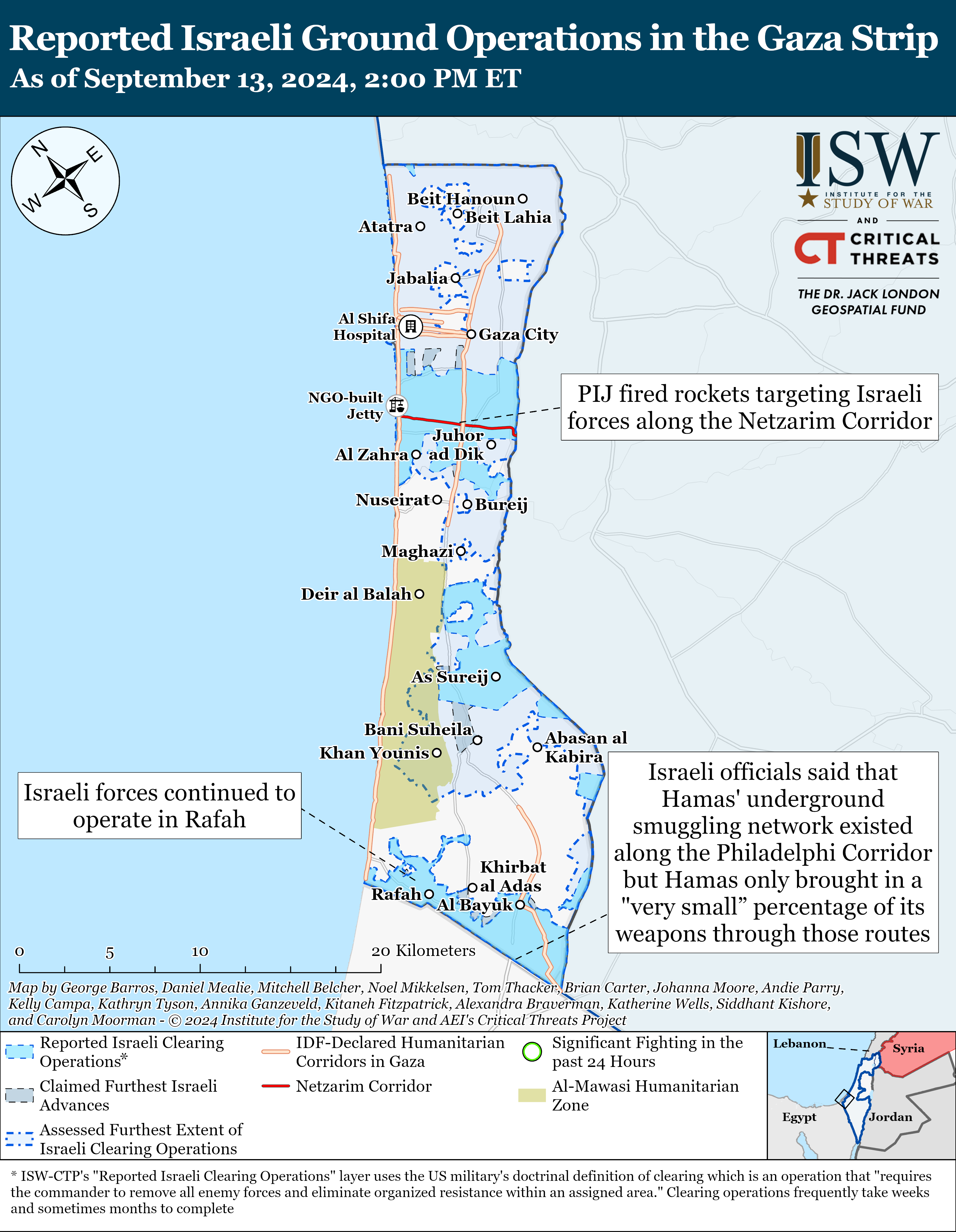 Institute for the Study of War Backgrounder 13 September Gaza Palestinian Islamic Jihad (PIJ) fired rockets targeting Israeli forces along the Netzarim Corridor on September 13. The IDF continued clearing operations in Rafah on September 12. Commercially available satellite imagery captured on September 12 shows flattened terrain and destroyed buildings northeast of Taha Hussein Street in Rafah, Israeli officials emphasized that Hamas' underground smuggling network existed along the Philadelphi Corridor but that Hamas only brought in a "very small” percentage of its weapons through those routes. The former director of Shin Bet, Nadav Argaman, told Israeli media that only a “very small number of weapons” had been smuggled into Gaza through the tunnels since Egypt had made concerted efforts to clear the border of tunnels between 2013 and 2016. The IDF discovered a tunnel beneath the Philadelphi Corridor wide enough for large vehicles to pass through on August 4. Images of the tunnel entrance, though, show that the tunnel probably travels south towards the Egypt-Gaza Strip border, which is only a few hundred meters south of the tunnel entrance. Israeli military correspondents reported the large tunnel in question did cross into Egypt but was not active at the time it was found. Hamas reportedly collapsed a portion of the tunnel on the Rafah side, and the IDF reported that the tunnel was also collapsed from the Egyptian side. Humanitarian aid groups completed the first phase of a mass polio vaccination campaign in the Gaza Strip. Over 560,000 Gazan children under the age of 10 have received the first of two polio vaccines since the campaign began on September 1. West Bank Israeli forces engaged Palestinian fighters in three locations in Tubas, south of Jenin. Palestinian Islamic Jihad (PIJ) mourned the deaths of five fighters, members of PIJ’s manufacturing and engineering unit. killed in Tubas on September 13. The IDF said on September 13 that it located an explosive-laden vehicle with a remote detonator in the Faraa refugee camp in Tubas during its recent operations; an airstrike destroyed the vehicle, citing Palestinian sources. The IDF said on September 12 that it killed three senior PIJ fighters in a drone strike in the Nour Shams refugee camp in Tulkarm on September 11. The IDF discovered a small tunnel during a multi-day operation in Tulkarm; the tunnel was near a hospital in the Tulkarm refugee camp. The tunnel had only one entrance, which could indicate the tunnel was still under construction. The al Qassem Brigades—Hamas' military wing—said that its fighters continue to engage Israeli forces across the Gaza Strip. Hamas has not claimed many individual attacks targeting Israeli forces in the Gaza Strip in recent weeks, however. Lebanon and Jordan Hezbollah conducted 11 attacks into northern Israel including approximately 20 rockets targeting the IDF’s Northern Command air defense base in Safed. Hezbollah separately conducted a drone attack targeting the headquarters of the IDF 210th Division in Safed.The IDF reported that the drone fell in Upper Galilee and caused no casualties. Hamas leader Yahya Sinwar sent a letter to Lebanese Hezbollah Secretary General Hassan Nasrallah vowing to continue Hamas’ fight against Israel. Sinwar wrote the letter after former Hamas political leader Ismail Haniyeh’s death on July 31. Sinwar thanked Nasrallah for Iranian-backed groups' efforts to support Hamas since the beginning of the Israel-Hamas war. Iran and the Axis of Resistance The US Embassy in Baghdad assessed that Iranian-backed Iraqi militias likely conducted the attack on a US diplomatic compound near Baghdad International Airport on September 10. Iranian-backed Iraqi militants seem to have conducted the attack against the wishes of Iranian-backed Iraqi militia Kataib Hezbollah and the Islamic Resistance in Iraq, which is a coalition of Iranian-backed Iraqi militias. Iranian-backed Iraqi militia Kataib Sayyid al Shuhada Secretary General said Iranian-backed Iraqi militias will soon begin their fourth phase of operations against Israel. This phase will include joint military operations and coordinated actions between Iranian-backed Iraqi groups and other Axis of Resistance members across multiple fronts. Walai outlined the previous three operational phases. In the first phase, Iraqi groups attacked US bases before attacking Israel in the second phase. In the third phase, Iranian-backed Iraqi groups conducted joint operations with the Houthis. The Islamic Resistance in Iraq, a coalition of Iranian-backed Iraqi militias that includes Kataib Sayyid al Shuhada, conducted over 170 attacks targeting US forces in Iraq and Syria between October 2023-January 2024. Other Iranian-backed Iraqi militias have conducted occasional attacks on US forces in Iraq and Syria since January 2024, but the Islamic Resistance in Iraq targeted Israel in most of its attacks after January 2024. View Quote  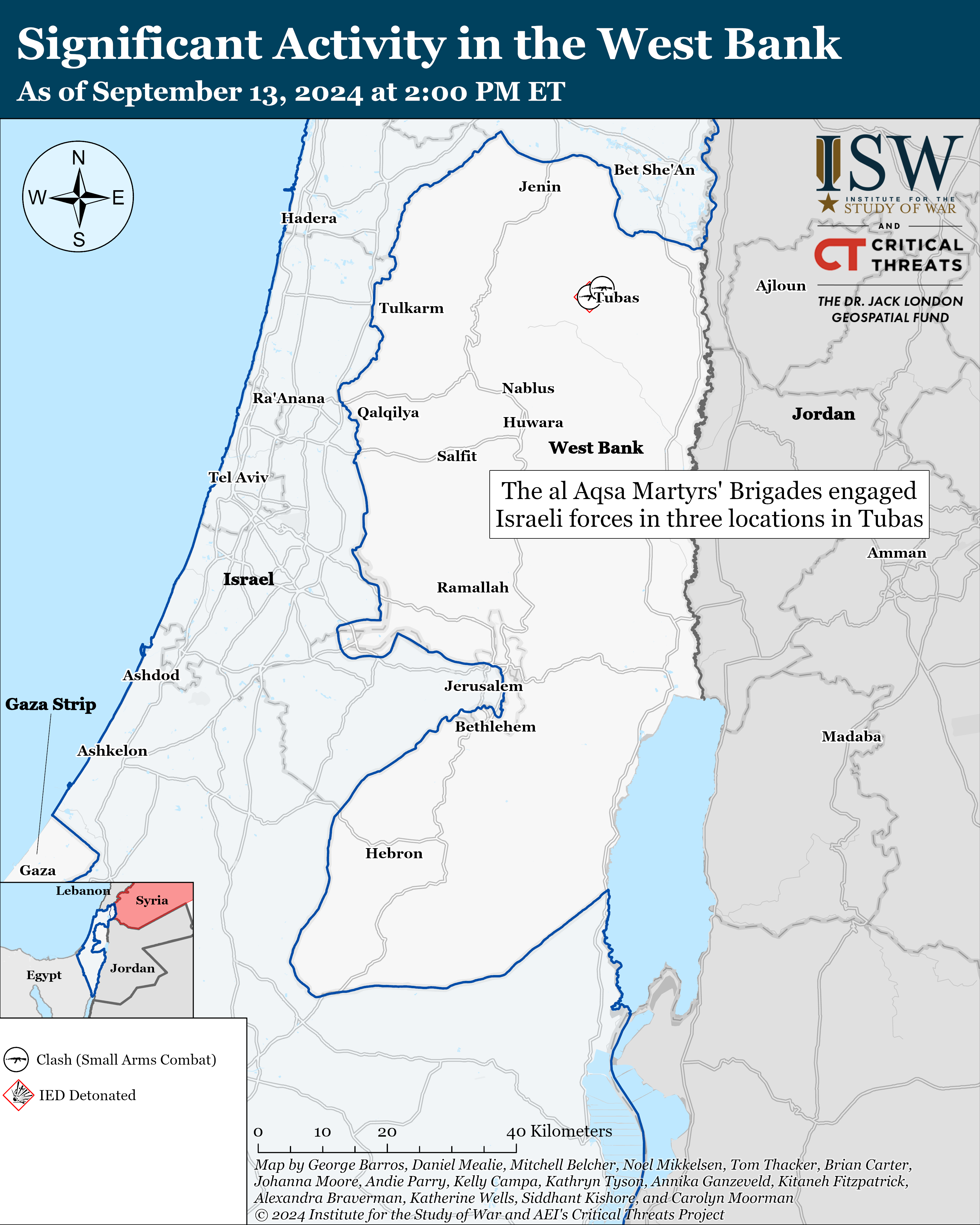 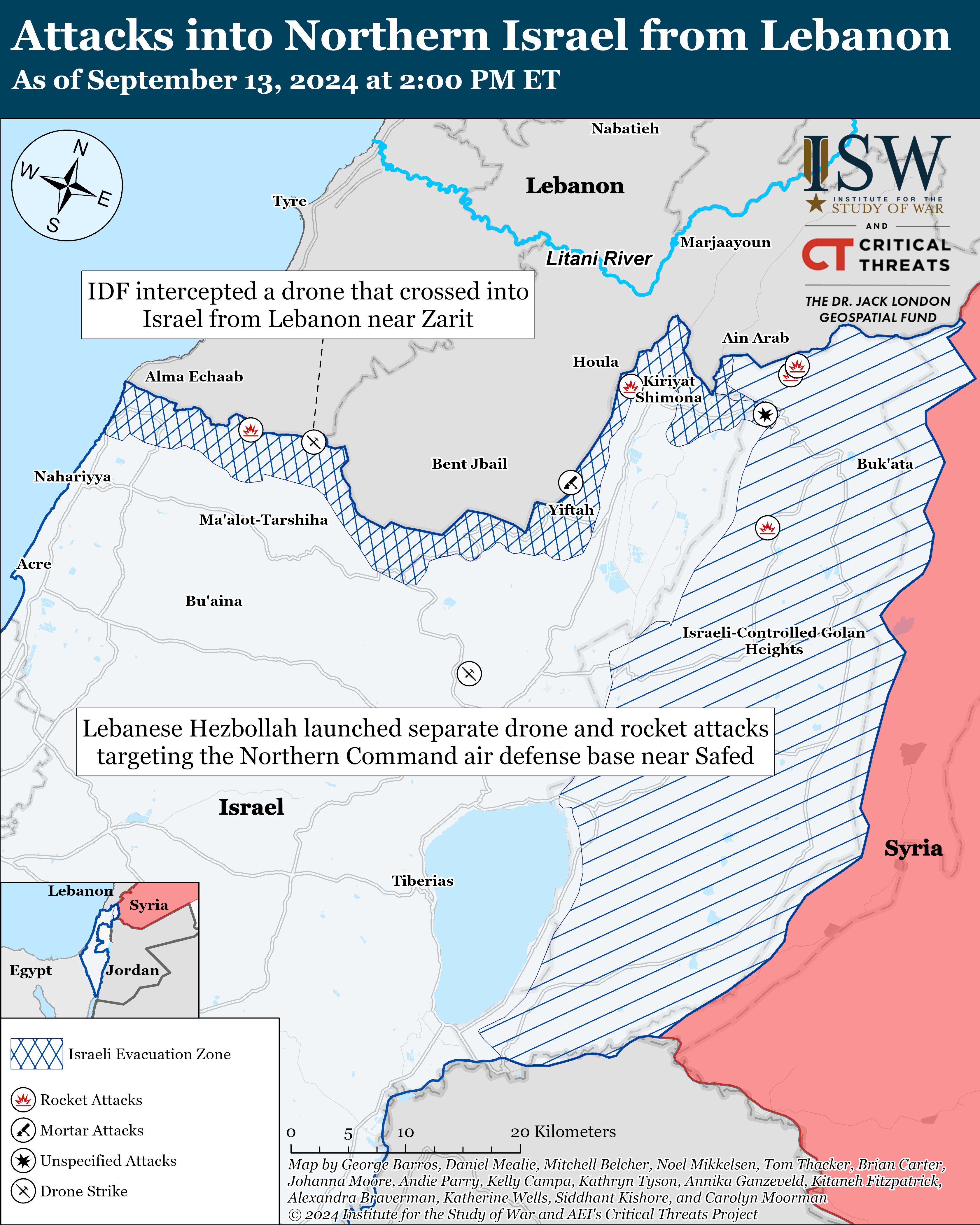
|
|
|
"A dying culture invariably exhibits personal rudeness. Bad manners. Lack of consideration for others in minor matters. A loss of politeness, of gentle manners, is more significant than is a riot."
Robert A. Heinlein, Friday |
|
On a side note: (I didn't see anything posted about it in it's own thread)
|
|
|
|
Two buildings used by Hamas in Gaza City's Sheikh Radwan neighborhood, close to a school used as a shelter for displaced Palestinians, were struck by Israeli fighter jets earlier today, the IDF says. The military says the buildings were used by Hamas operatives for various attacks and to manufacture weapons. The IDF denies some Palestinian reports that the strike targeted a fuel facility in the area, near the Dar al-Arqam School. The Hamas-run civil defense reports five dead in the strike. The IDF says it took steps to mitigate civilian harm in the strike, and accuses Hamas of "systematically" using civilian sites for terror. View Quote
Some 55 rockets were launched from Lebanon at the Safed area this morning. The IDF says several rockets were intercepted by air defenses, while many others struck open areas. There were no injuries in the attack. One launcher used in this morning's rocket fire was destroyed in a drone strike, the military says. Another airstrike targeted a launcher used in an overnight barrage on Safed. A separate strike hit a building used by Hezbollah in southern Lebanon's Kfar Roummane, the IDF adds. View Quote
Article from X post below: Hamas terrorists have confiscated so much humanitarian aid that the terror group is struggling to find space in warehouses to store all of it, according to intercepted communications between Hamas operatives that were played during an episode of N12's "Ulpan Shishi" on Friday. These intercepted communications feature Hamas operatives discussing the movement of goods from overflowing humanitarian aid warehouses to Khan Yunis. “We’ve got trucks filled with goods alongside the diesel trucks,” one operative said. “At this point, we have everything... The warehouse is at full capacity. We’re just waiting for the green light to start transferring.” The second operative responded, “Coordinating with Samer is difficult due to a reception issue. If you can move them elsewhere, go ahead.” The first operative then asked, “Can you take them to Khan Yunis, or will that cause a delay?” This short exchange illustrates the significant flow of aid into Gaza, broadcasters said during the episode. What began with two trucks entering Gaza before the agreement has now grown into 200 trucks arriving daily. Hamas seizes these supplies, gaining complete control over the warehouses without resistance, they said. They also mentioned how the recordings not only expose how Hamas takes control of these shipments but also highlight the absurdity of the situation—the terrorist organization is running out of space to store the aid. Clearly, this aid is not being used for humanitarian purposes but is instead aiding the enemy. Hamas exerts full control over food and medicine distribution. Meanwhile, the Coordinator of Government Activities in the Territories, Maj.-Gen. Ghassan Alian attempted to regulate the aid by involving Gaza-based merchants who had been active before the war in managing the inflow of supplies. Hamas exploited this by taking 20% of the merchants' profits. As a result, it was decided that starting next week, Alian would halt the aid transfer to these merchants. View Quote
|
|
|
"A dying culture invariably exhibits personal rudeness. Bad manners. Lack of consideration for others in minor matters. A loss of politeness, of gentle manners, is more significant than is a riot."
Robert A. Heinlein, Friday |
|
|
|
"A dying culture invariably exhibits personal rudeness. Bad manners. Lack of consideration for others in minor matters. A loss of politeness, of gentle manners, is more significant than is a riot."
Robert A. Heinlein, Friday |
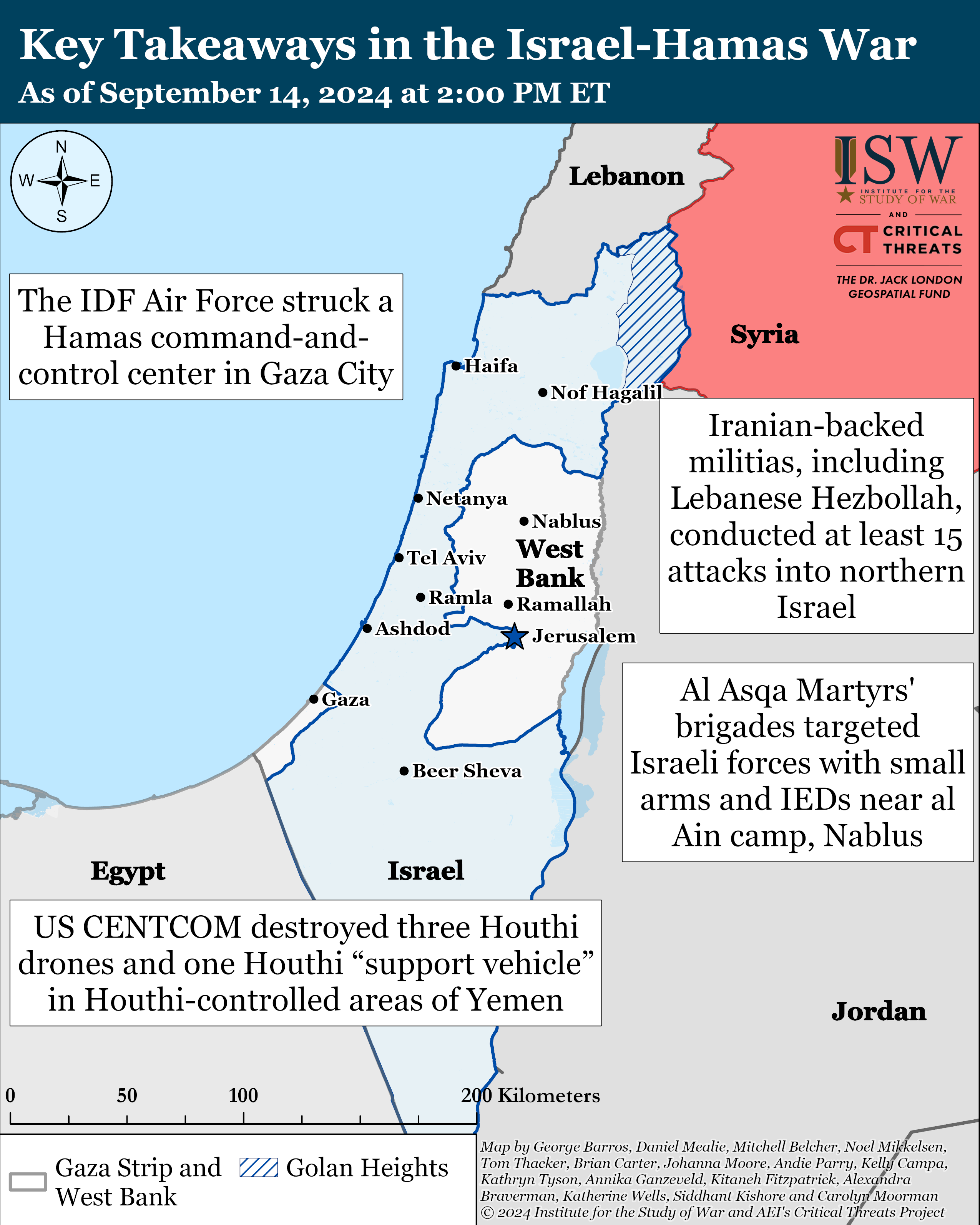 Institute for Study of War Backgrounder 14 September Gaza The Air Force struck two buildings in Sheikh Radwan, Gaza City, where Hamas fighters were operating. The buildings were located near the Dar al Arqam school currently being used as a shelter for displaced Gazans. The IDF denied reports that it targeted a fuel refinery in the area. The Hamas-run Gazan Civil Defense reported that the strike killed five Palestinians. The IDF Air Force attacked a second Hamas command-and-control center in Gaza City that was based in the former Zaytoun Martyrs School. The al Aqsa Martyrs’ Brigades—the self-proclaimed militant wing of Fatah—and the National Resistance Brigades launched separate rocket and mortar attacks targeting Israeli forces around the Netzarim Corridor. In Rafah, the 162nd Division killed over 100 Hamas fighters and located Hamas stockpiles of rifles, ammunition, anti-tank munitions, hand grenades, and tunnel entrances. They "surveyed” kilometers of tunnels in Tel al Sultan over the past week. The IDF issued new evacuation orders on September 14 for neighborhoods in Beit Lahia after Palestinian fighters launched two rockets from the northern Gaza Strip. West Bank Israeli forces engaged Palestinian fighters in two locations in the West Bank. Lebanon Hezbollah launched multiple attacks using dozens of rockets into northern Israel in retaliation for Israeli strikes in southern Lebanon. Two of the rocket attacks reached Safed and Elifelet, north of the Sea of Galilee. This is the first time Hezbollah has targeted Elifelet since October 8. Yemen CENTCOM destroyed three Houthi drones and one Houthi “support vehicle” in Houthi-controlled areas of Yemen. View Quote 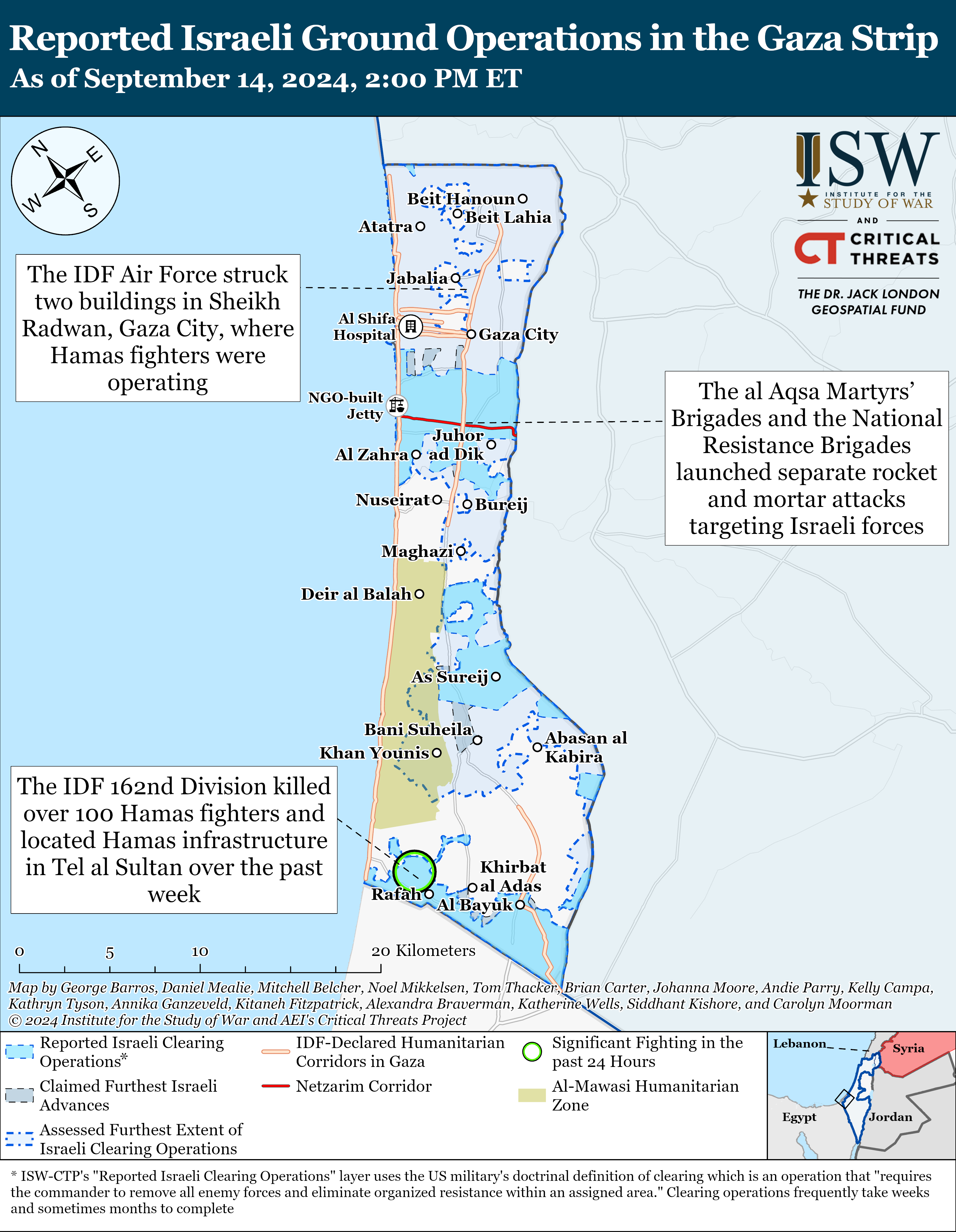 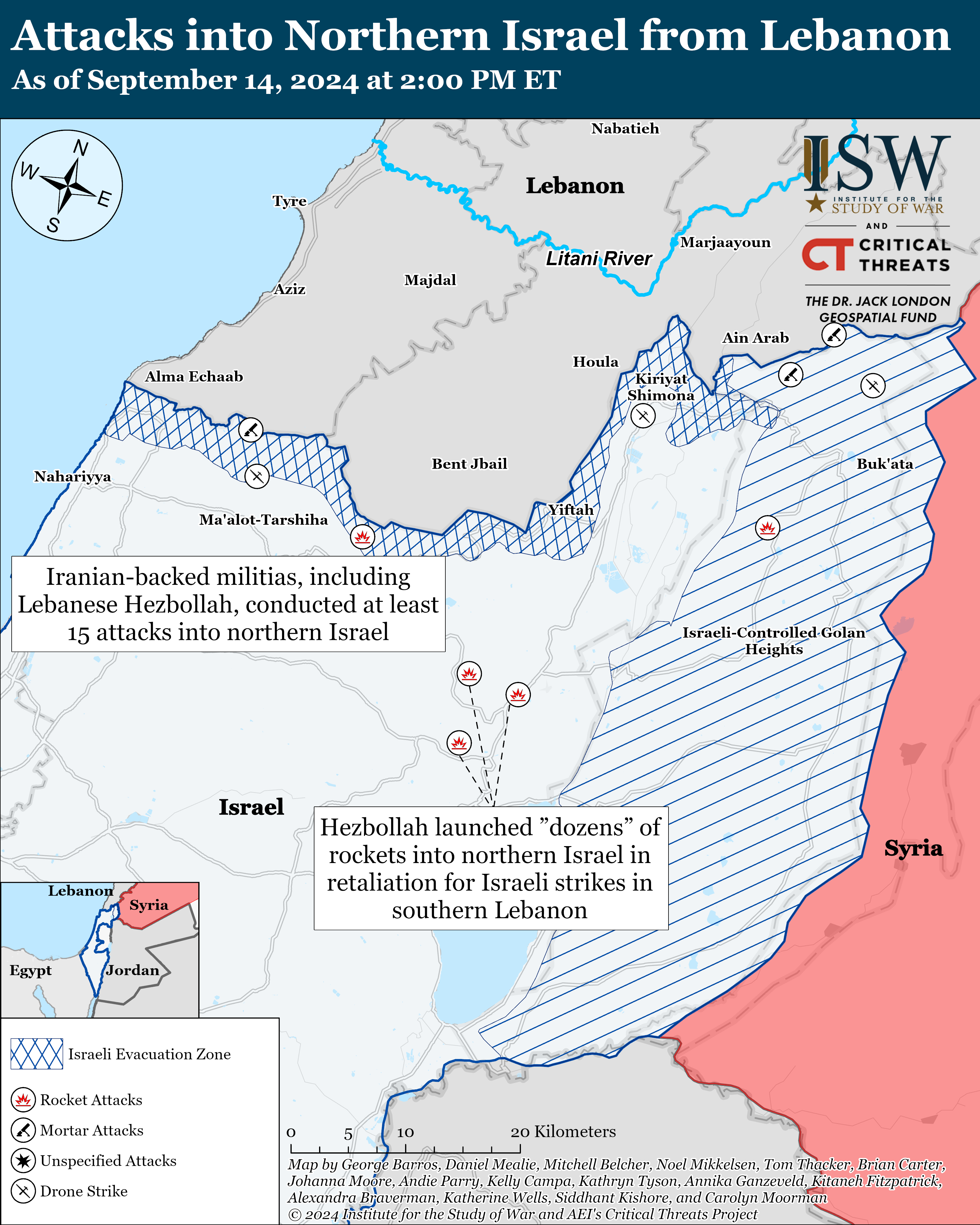
|
|
|
"A dying culture invariably exhibits personal rudeness. Bad manners. Lack of consideration for others in minor matters. A loss of politeness, of gentle manners, is more significant than is a riot."
Robert A. Heinlein, Friday |
|
The Iranian Foreign Legion
The Houthi group has been transferring fighters from its forces to Syria in preparation for a new phase of escalation against Israel… -Sputnik @nourabohsn There have been several drills where the Houthis rehearse seizing an Israeli town and capturing IDF soldiers as hostages. View Quote Link to all liveblog articles below---here. There will be another 100+ rocket day tomorrow--IDF attacked Hezbollah munitions depot deep inside Lebanon, as well as country's south The IDF confirmed that Israeli fighter jets attacked Hezbollah military depots in the Beqaa and Baalbek regions, deep inside Lebanese territory. The army added that it also attacked Hezbollah military warehouses and structures in seven different areas in south Lebanon. View Quote Officials: Hamas won't demand Israeli pullout from Philadelphi during truce if timeline is set for war's end Senior Hamas officials recently told representatives of other Palestinian organizations that it had expressed a willingness to postpone an Israeli withdrawal from two key strips of land until a deal concludes its final stage. The proposal would allow Israel to remain in the Philadelphi route (along the Gaza-Egypt border) and Netzarim corridor (which bisects Gaza) during the implementation of the deal's different stages, on the condition that a timetable be set for Israel's full withdrawal from Gaza and a complete end to the war. Palestinian officials who spoke with Hamas officials in Qatar say Hamas believes Prime Minister Benjamin Netanyahu doesn't want an agreement that would see the war end and Israel's full withdrawal – and that he's prepared to pursue the war until at least the U.S. presidential election is over. These officials say that while Hamas has informed mediators that it was willing to discuss the new outline, Hamas says it has no intention of being flexible on the deal including an end to the war. View Quote Condition of seven Israeli soldiers wounded in Gaza helicopter crash improves The condition of seven soldiers who were wounded in a helicopter crash in the Gaza Strip on Wednesday has improved. Four of the soldiers remain hospitalized in intensive care units in moderate to serious condition, and two others are in surgical wards in moderate condition. One soldier has moved for further treatment closer to his home. Two soldiers were killed in the crash overnight into Wednesday near the Philadelphi route along the Gaza-Egypt border. The incident occurred during an operation to evacuate a wounded soldier. The seven other soldiers were all seriously wounded in the crash. View Quote
Telling it like it is @DouglasKMurray “Hamas leadership have said themselves they want to use Palestinian children in order to pressure the world. These are fanatics. They want the death of their own citizens to get world attention turned against Israel. How do you negotiate with that?” View Quote
|
|
|
"A dying culture invariably exhibits personal rudeness. Bad manners. Lack of consideration for others in minor matters. A loss of politeness, of gentle manners, is more significant than is a riot."
Robert A. Heinlein, Friday |
|
|
|
|
|
All they had to do is pull the compact lever.

|
|
|
|
|
Impressive that the Houthi’s actually hit near Tel Aviv with a ballistic missile. They have done better than Iran.
|
|
|
A lot like GD. Obsessed with the latest shiny weapon but never budgets enough for the ammo... jwnc 5/9/2024
|
|
Originally Posted By GoldenMead: Impressive that the Houthi’s actually hit near Tel Aviv with a ballistic missile. They have done better than Iran.
View Quote Iranians fired this one, too. Houthi aerospace engineer pictured below: 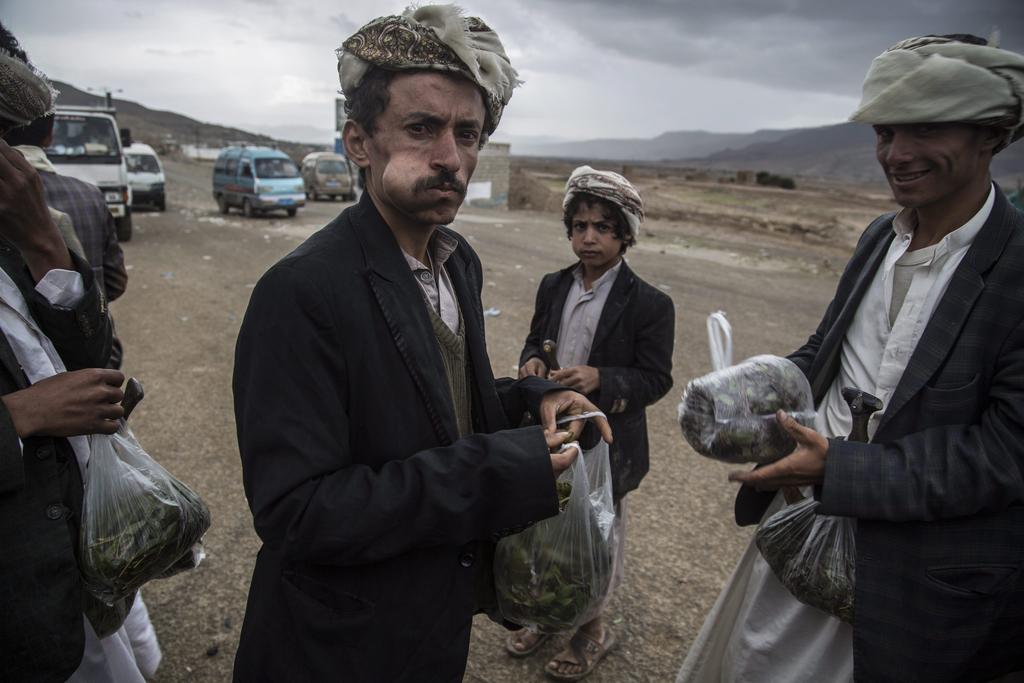 Part of the problem is the Israelis are geared up for threats from the north and east. They have known, though, that any big fight means attacks from all of the Axis countries and movements. |
|
|
"A dying culture invariably exhibits personal rudeness. Bad manners. Lack of consideration for others in minor matters. A loss of politeness, of gentle manners, is more significant than is a riot."
Robert A. Heinlein, Friday |
|
Link to liveblog
IDF: Missile fired this morning from Yemen seemingly fell apart while airborne The Israeli army said that the surface-to-surface missile launched Sunday morning from Yemen towards Israel apparently fell apart midair. The IDF added that it is still assessing the results of the interception attempts by the Arrow and Iron Dome systems that were activated in response. View Quote Longer article in quote box Yemen's Houthis launch 'new hypersonic ballistic missile' at central Israel, causing fire. Link Houthi military spokesperson Yahya Saree said that the missile was fired toward an Israeli military target and that the IDF's aerial defense systems failed to intercept it. The IDF said that the missile apparently fell apart midair A surface-to-surface missile launched from Yemen landed in an open area in central Israel on Sunday, the military announced. Sirens blared in communities throughout a wide swath of central Israel and the Shfela region. Interceptors from the Arrow and Iron Dome systems were deployed, and the military is currently assessing whether there was a successful interception. Houthi military spokesperson Yahya Saree said in a statement that the Houthis have launched a "new hypersonic ballistic missile" toward an Israeli military target and that the IDF's aerial defense systems failed to intercept it. According to Saree, the missile managed to cross 2,040 kilometers (some 1267 miles) in 11 minutes. The Israeli army said that the surface-to-surface missile launched Sunday morning from Yemen towards Israel apparently fell apart midair. The IDF added that it is still assessing the results of the interception attempts by the Arrow and Iron Dome systems that were activated in response. Shrapnel fell near a train station on the outskirts of the city of Modi'in, causing damage, while a fire broke out in an open area in the moshav of Kfar Daniel near Lod, likely due to additional falling fragments. No changes in the Home Front Command's instructions have been announced. Emergency services reported no injuries directly from the missile or interceptors. However, nine people sustained minor injuries while rushing to protected spaces. The police say they are handling the site where interceptor fragments fell in Modi'in. On Friday, the defense minister in the Iran-backed Houthi government condemned "the evil trio of America, Britain and Israel" and said "the coming days hold surprises they will not expect" and would be "a nightmare for the enemies." Lebanese television channel Al-Mayadeen quoted a senior Yemeni official as saying that details about the missile's target and the type of missile used would be released later in the day. The official added that "as long as the aggression in Gaza and the West Bank continues," Israel should expect further attacks on Tel Aviv and other locations in the country. In July, Yemen launched a drone that exploded over Tel Aviv. Evgeny Ferder, a 50-year-old city resident, was killed by shrapnel that penetrated his apartment, and eight people were wounded by the blast. In response, Israel struck oil and power facilities in the Yemeni port city of Hodeidah, which it described as "military targets used by the Houthis." Several people were killed and at least 80 wounded in the attack. The military said after the strike that it had been carried out "in response to hundreds of attacks against the State of Israel in recent months," and that the targeted port was used by the Houthis to receive weapons from Iran. It added that striking infrastructure facilities would inflict economic damage on the Houthis. A senior Houthi official said after the attack, "Yemen will certainly respond to this aggression. Yemen's support for Gaza is principled and will not change." Yahya Saree, the Houthi military spokesman, declared, "We will not stop our attacks and will respond accordingly to civilian targets and enemy facilities as well. We declare that the Jaffa area [the Tel Aviv area] will not be safe." Also Sunday, 40 rockets were launched into northern Israel from Lebanon. The military said several rockets were intercepted and the rest fell in open areas. No injuries were reported, but fires were ignited in several locations. View Quote Crater from the Houthi missile  Shrapnel from an interceptor at the train station in Modi'in, Sunday. 
|
|
|
"A dying culture invariably exhibits personal rudeness. Bad manners. Lack of consideration for others in minor matters. A loss of politeness, of gentle manners, is more significant than is a riot."
Robert A. Heinlein, Friday |
Article from X post Houthi missile attack on Israel: Iranian axis is not deterred - analysis Just after 6:30 in the morning, sirens were heard throughout central Israel. The sirens sent large numbers of Israelis to shelters and led to questions in Israeli media about whether schools would operate as usual on Sunday, September 15. The September 15 missile attack now joins a large number of unprecedented attacks on Israel since October 7. The recent attacks, such as the Hezbollah escalation on August 25, the Houthi drone attack on Tel Aviv on July 19, and the April attack by Iran, all illustrate that Iran and its proxies are not deterred. Iran and its proxies are seeking to ring Israel with attacks on numerous fronts from various directions. This is why the Houthis launched a drone at Israel that flew in from the Mediterranean in July. The drone exploded a block away from the US Embassy branch office in Tel Aviv, the former site of the US embassy, which was moved to Jerusalem in 2018. This was a major attack. It killed one person, and it symbolically showed that the Houthis and Iran’s axis could reach Tel Aviv with drones. Tel Aviv had already been targeted by Hamas rockets since October 7. However, the expansion in Iranian-backed attacks in the past year is unprecedented. It is not just unprecedented in terms of Iran and its proxies. It is unprecedented in Israel’s history. Israel has been threatened from multiple fronts in the past, such as in 1967. Tel Aviv has also been threatened in the past, for instance the Egyptians bombed Tel Aviv in the 1948 war. However, when one adds up all the attacks on Israel over the past 11 months, the Iranian adversary has broken through a number of historic norms and spread the threats to a new level. The attack on September 15 now joins this list. The real story here is that Iran and its proxies are not deterred. Israel has largely been on the defensive since October 7. After Israel was surprised by the massive Hamas attack, it had to mobilize troops and respond. Today, Hamas has lost thousands of fighters in Gaza, and the IDF controls the Philadelphi corridor and a corridor across central Gaza. However, Hamas controls most of Gaza. Hamas attempted to target Ashkelon on September 14 by firing a rocket from northern Gaza. This shows that Hamas continues to have rockets, and it is active in northern Gaza despite 11 months of fighting and the IDF entering some areas numerous times. With Hamas still active in Gaza, there are also escalations by Palestinian Islamic Jihad, Hamas, and other groups in the West Bank. These groups have rapidly expanded their threats in the last two years. They have stockpiled arms smuggled to the West Bank. They are well-armed with M-4 and AR-type rifles. The groups are also using more explosives and are even beginning to build tunnels. They have expanded their operations to areas such as Tubas, from Jenin. This has caused the IDF to launch an unprecedented large operation against terror in the West Bank in August. The IDF now uses drones to carry out strikes in the West Bank. This is now another new norm. None of this would have been normal two years ago. View Quote
In the wake of the Houthi attack on Israel this morning there have already been rounds of attacks by Hezbollah, illustrating the multi-front war by Iranian-backed groups that are seeking to ring Israel with attacks and threats. The proxies are not deterred and they want this to be the new normal. View Quote
|
|
|
"A dying culture invariably exhibits personal rudeness. Bad manners. Lack of consideration for others in minor matters. A loss of politeness, of gentle manners, is more significant than is a riot."
Robert A. Heinlein, Friday |
The ballistic missile launched by the Iran-backed Houthis from Yemen at central Israel this morning was hit by an interceptor missile, although it did not manage to completely destroy the target, according to an Israeli Air Force probe. The missile had been identified upon launch from northwestern Yemen early this morning, and the Arrow long-range defense system was activated to intercept it. Several interceptor missiles were launched at the target in attempts to down it. At least one of the Arrow interceptors hit the missile, but did not destroy it completely, the probe finds. Instead, the interceptor caused the Houthi missile to break apart in the air, and the warhead, as well as other pieces, fell to the ground. The missile shrapnel impacted open areas in the Ben Shemen forest, close to Kfar Daniel, sparking a fire. Shrapnel from the interceptors also hit a train station near Modiin, causing slight damage. The IAF has found that the missile, which had a straight trajectory, was not a hypersonic projectile, as the Houthis have claimed. View Quote
The IDF says it carried out an airstrike against a group of Hamas operatives at a command room embedded within a former school in the northern Gaza Strip a short while ago. According to the military, Hamas was using the Ghazi Al-Shawa School in Beit Hanoun as a hideout and to prepare rocket attacks in recent weeks. The school has been serving as a shelter for displaced Gazans, according to Palestinian media. The IDF says it took steps to mitigate civilian harm in the strike, and accuses Hamas of "systematically" using civilian sites for terror. View Quote
This got a lot of attention in Argentina, as Leon Gieco, an Argentine singer, is Ron Sherman's uncle.
Ten months after their bodies were recovered, the IDF says that its investigation has found that former hostages Sgt. Ron Sherman, Cpl. Nik Beizer, and civilian Elia Toledano, were killed as a result of a “byproduct” from an Israeli airstrike in the Gaza Strip, although the exact cause of death is still unknown. On November 10, 2023, the IDF carried out an airstrike near the location where the bodies were later found, targeting the commander of Hamas’s Northern Gaza Brigade, Ahmed Ghandour, who was hiding in a tunnel in Jabaliya. “The findings of the investigation suggest that the three, with high probability, were killed by a byproduct of an IDF airstrike, during the assassination” of Ghandour, the IDF says. “This is a highly probable estimate given all the data, but it is not possible to determine with certainty the circumstances of their death,” the military says. The IDF says it was able to determine that they were likely indirectly killed by the strike on Ghandour based on the locations where the bodies were found in relation to the site of the airstrike, an investigation of the airstrike, intelligence findings, pathology reports, and findings made by the Abu Kabir Forensic Institute. According to the IDF’s investigation, the three were held in a tunnel complex where Ghandour also operated, though when the strike was carried out, the military had no information on hostages being held in the area. The IDF probe found that at the time, it had information on another location where it thought the hostages were being held, and therefore the tunnel complex was not listed as an area where Israeli abductees could be. Amid the war, the IDF has said it does not strike in areas where it has information of hostages being, but in some cases hostages have been harmed in Israeli strikes due to a lack of intelligence. On December 14, the bodies of Sherman, Beizer, and Toledano were found in the tunnel network in Jabaliya and brought back to Israel for burial. Sherman and Beizer were both kidnapped from an IDF base near the Gaza border on October 7, while Toledano was abducted from the Supernova rave near Kibbutz Re’im, when thousands of Hamas-led terrorists burst across the border into Israel, slaughtering some 1,200 people and seizing 251 hostages, mostly civilians, while committing acts of brutality and sexual assault. View Quote
Last Houthi attack on shipping was 8 September. |
|
|
"A dying culture invariably exhibits personal rudeness. Bad manners. Lack of consideration for others in minor matters. A loss of politeness, of gentle manners, is more significant than is a riot."
Robert A. Heinlein, Friday |
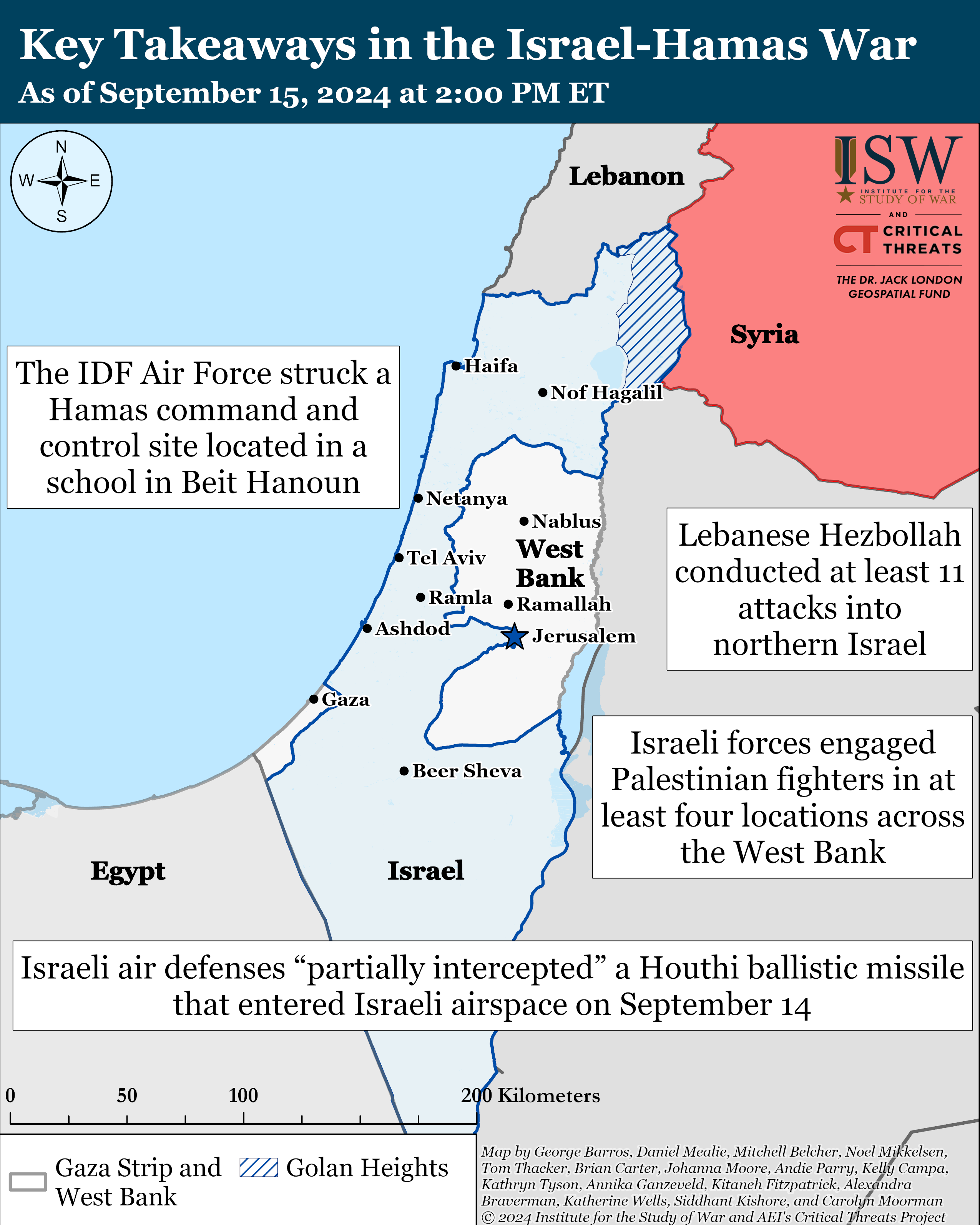 Institute for Study of War Backgrounder 15 September Gaza The Air Force struck a Hamas command-and-control center in he former Ghazi al Shawa School Beit Hanoun. The al Aqsa Martyrs’ Brigades—the military wing of Fatah—launched rockets at Israeli forces along the Netzarim Corridor south of Gaza City. Hamas conducted a relatively simple but multi-stage attack on Israeli forces in eastern Rafah City. In the al Janina neighborhood, Hamas attacked a D9 bulldozer using a rocket propelled grenade (RPG) and attacked the Israeli quick reaction force with another RPG. 162nd Division continues to operate in Rafah, predominately in the west. The IDF also remains along the Philadelphi Corridor, the border zone between the Gaza Strip and Egypt that spans all of Rafah. West Bank Israeli forces engaged Palestinian fighters in four locations across the West Bank. Israeli forces thwarted an infiltration attempt on September 14. Israeli forces detained 23 Palestinians at the Maccabim Security Checkpoint on Route 443 who were traveling in a garbage truck. Israeli Police raided a compound in Yafia, a town near Nazareth, on September 15 as part of an operation to curb criminal activity in northern Israel. Israeli police located a tunnel in the compound and recovered four small arms, ammunition and an unguided anti-tank rocket. Israeli media reported that the Israeli Northern District Police have launched a ”large-scale operation” in recent days to curb violent crime near Nazareth. Lebanon Lebanese Hezbollah has conducted at least 11 attacks into northern Israel. Hezbollah fired one-way attack drones at an IDF site in the Golan Heights. One of the drones flew 30 kilometers inside Israeli territory before exploding near a kibbutz. An IDF brigade commander in northern Israel issued evacuation orders for areas of southern Lebanon without coordinating with Israeli political leadership or higher IDF headquarters. IDF 769th Brigade Commander Colonel Avi Marciano dropped evacuation orders leaflets by drone over the al Wazzani area of southern Lebanon. Hezbollah had recently launched rockets from the area. The flyers ordered residents to evacuate north to the al Hiyam area and not to return to the area "until the end of the war" or they would be considered combatants. The Air Force conducted airstrikes on Hezbollah weapons depots “deep” in eastern Lebanon, striking sites in Baalbek and the Bekaa Valley, including a depot near the Syrian-Lebanon border 140 kilometers from Israel. Iran and Axis of Resistance The Islamic Resistance in Iraq—a coalition of Iranian-backed Iraqi militias—claimed a drone attack targeting an unspecified target in Haifa, Israel, on September 15. Houthi missile attack Israeli air defenses “partially intercepted” a Houthi ballistic missile that entered Israeli airspace on September 14. This is the third time that a Houthi missile or drone has entered Israeli airspace from Yemen since October 7. The Houthis claimed that the attack targeted an unspecified military target in the Tel Aviv area with a “new hypersonic missile”. Missile and interceptor fragments damaged and set fire to several areas but did not strike populated or military targets. The Houthis did not say that the strike was in response to a specific event, but the attack coincided with the Prophet Mohammad's birthday. Hezbollah similarly chose a religious occasion—Arbaeen—to conduct its August 25 rocket and drone attack on northern and central Israel. The Houthi Defense Minister and Chief of Staff foreshadowed the attack on September 14, declaring to Israel that ”the coming days will bring you surprises that you will not expect” that would be ”more severe and harsher than what you have witnessed in the past.” View Quote 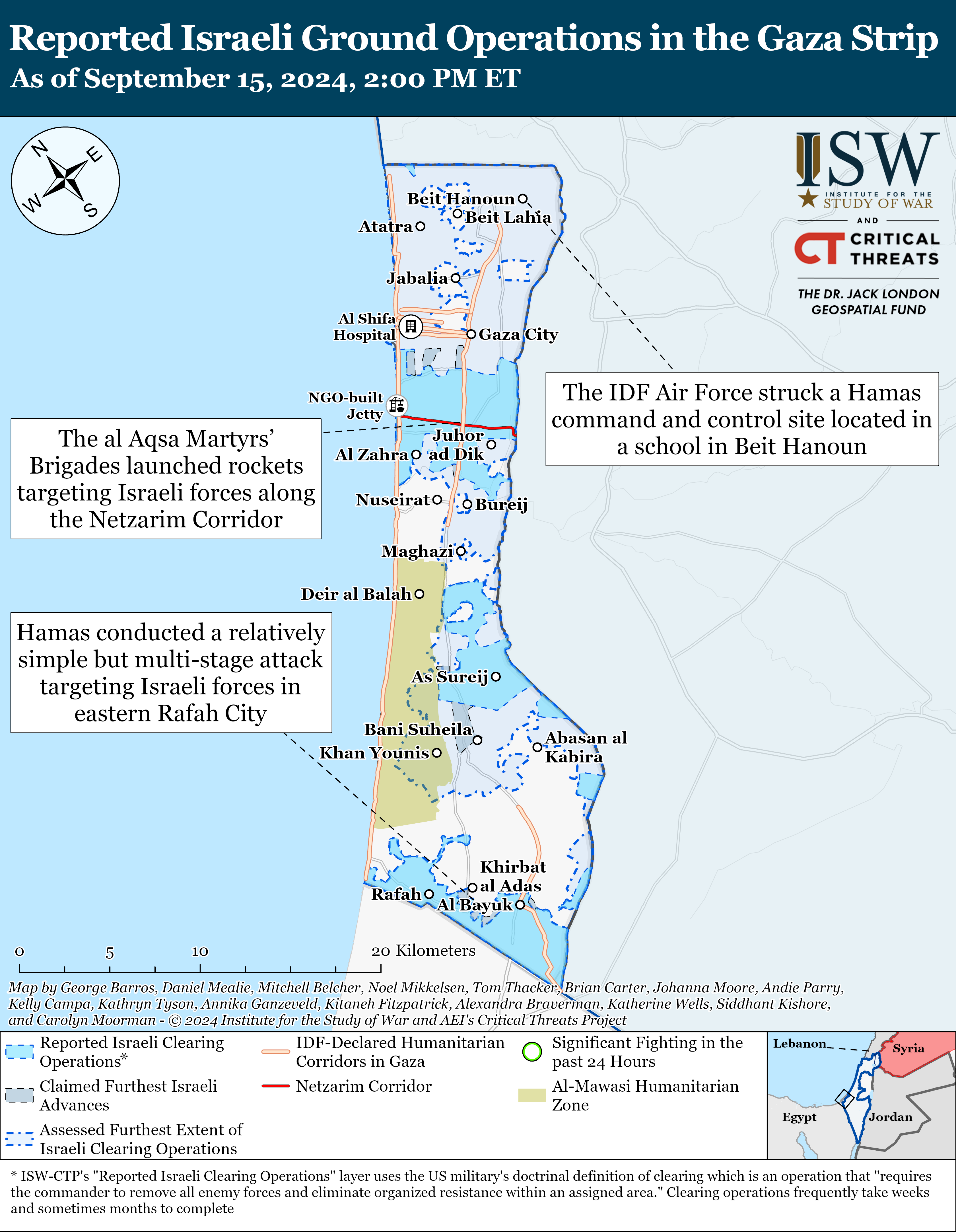 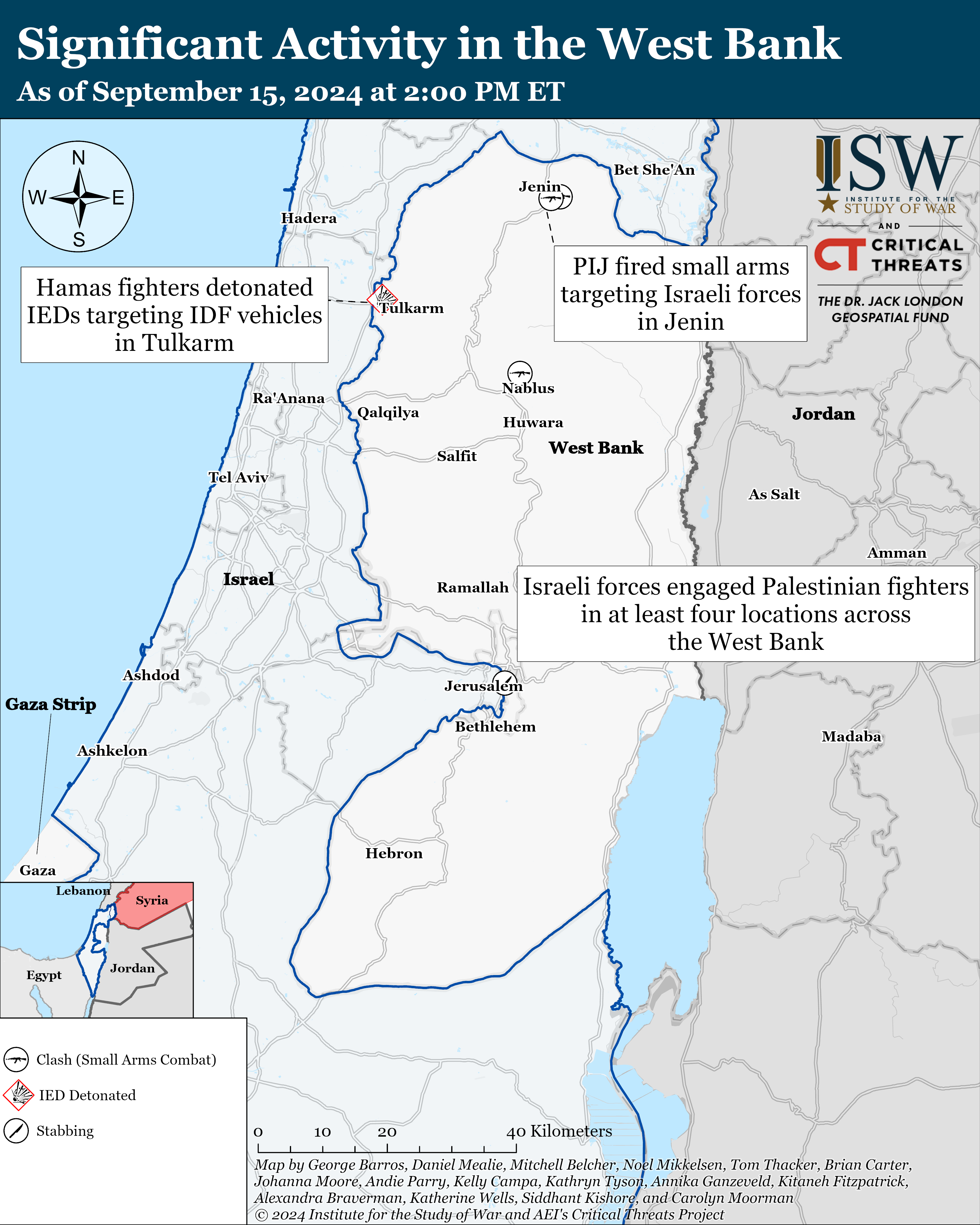 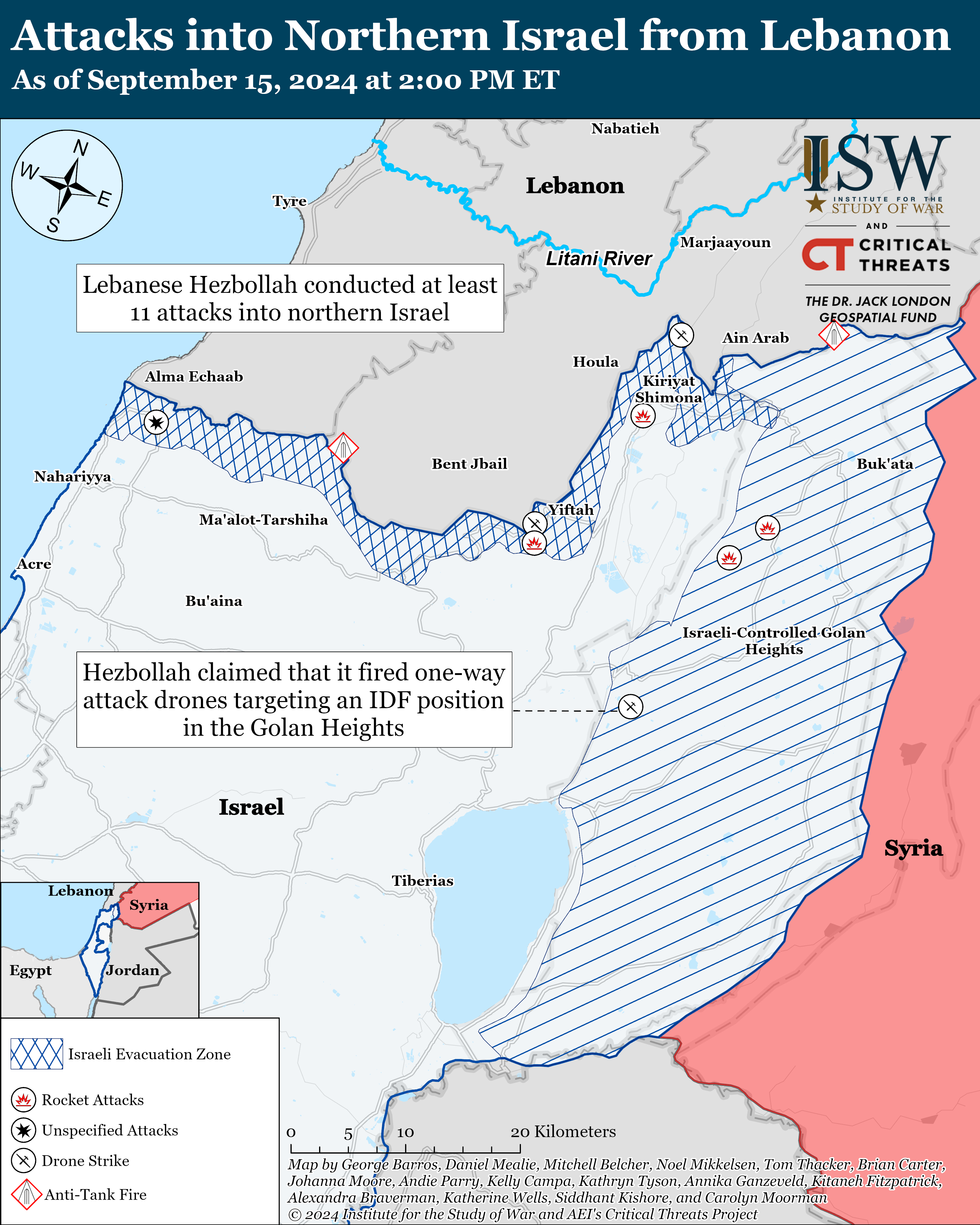
|
|
|
"A dying culture invariably exhibits personal rudeness. Bad manners. Lack of consideration for others in minor matters. A loss of politeness, of gentle manners, is more significant than is a riot."
Robert A. Heinlein, Friday |
|
Originally Posted By bcsoeod: sigh... At this point there's no way this just "ends" and everybody goes back to within their borders. There will be full scale war in the middle east within the next year. View Quote Not looking good. This has reached the point where this needs to be finished. All these countries claiming the Palestinians are worth fighting a war over won’t allow them asylum. Think about that. The UN and apparently some in our own government have obviously been using them for money laundering and bailing their asses out after they commit acts of terrorism against Israel and it’s time it stops. |
|
|
Saint Michael the Archangel, defend us in battle we humbly pray.
|
|
WSJ: The Crude System of Coded Messages Keeping Hamas’s Leader Alive: Yahya Sinwar’s use of low-tech communications has vexed Israel’s efforts to kill him. Link
Hamas’s top leader Yahya Sinwar could well be dead today if not for a low-tech communications system honed in prison that shields him from Israel’s intelligence-gathering dragnet. Sinwar has largely shunned phone calls, text messages and other electronic communications that Israel can track and that have led to the demise of other militants. Instead, he is using a complex system of couriers, codes and handwritten notes that allows him to direct Hamas’s operations even while hiding in underground tunnels. Sinwar’s rudimentary approach to communications harks back to a system that Hamas used in its early years and that the Hamas leader took up when he was detained in 1988 and later imprisoned in an Israeli jail, according to experts on the group. Before being incarcerated, Sinwar founded Hamas’s internal security police, called Majd, which hunted down suspected collaborators and was active in Israeli prisons. Majd recruited agents inside prison called “sawa’ed” who distributed encoded messages from one section to another View Quote Entire article in quote box The Crude System of Coded Messages Keeping Hamas’s Leader Alive Hamas’s top leader Yahya Sinwar could well be dead today if not for a low-tech communications system honed in prison that shields him from Israel’s intelligence-gathering dragnet. Sinwar has largely shunned phone calls, text messages and other electronic communications that Israel can track and that have led to the demise of other militants. Instead, he is using a complex system of couriers, codes and handwritten notes that allows him to direct Hamas’s operations even while hiding in underground tunnels, according to Arab cease-fire mediators. The communication method has vexed an Israeli military intent on finding the architect of the Oct. 7 attack on Israel that killed 1,200 people and sparked the war in Gaza. Killing or capturing Sinwar would mark a substantial victory for Israel that could bring the 11-month war closer to an end, but even with military control of the Gaza Strip, Israeli intelligence has come up empty. Sinwar hasn’t been seen in public since the war started last fall. Israeli officials have said they believe he is in hiding in Gaza. A glimpse into how Sinwar stays alive comes from Arab mediators who have ferried messages back and forth during cease-fire talks between Hamas and Israel, which don’t talk directly to each other. A typical message from Sinwar will now be handwritten and first passed to a trusted Hamas member who moves it along a chain of couriers, some of whom might be civilians, the mediators said. The messages are often coded, with different codes for different recipients, circumstances and times, building on a system that Sinwar and other inmates had developed while in Israeli prisons. The note might then reach an Arab mediator who has entered Gaza or another Hamas operative who uses a phone or other method to send it to the U.S.-designated terrorist group’s members abroad, the mediators said. Sinwar’s communications methods have become more guarded and complex as Israel has managed to find and kill his high-ranking compatriots, in particular the Beirut attack that killed Saleh al-Arouri, Hamas’s deputy political leader and a founder of the group’s military wing. “I’m quite sure this is one of the prominent reasons that the IDF didn’t find him,” said Michael Milshtein, a former head of Palestinian affairs for Israeli military intelligence, referring to the Israel Defense Forces. “He really keeps all his basic personal patterns of behavior very strict.” The Israeli military declined to comment. Hamas declined to answer questions about how Sinwar communicates. Sinwar has recently been firing off official messages to Arab and militant leaders, including thanks for their support and praise for the Yemen-based Houthi militants for their missile attack Sunday on Israel. Israel’s military intelligence has some of the world’s most sophisticated abilities to intercept electronic communications, often called signals intelligence. It was after Arouri’s death that Sinwar almost entirely shifted to handwritten notes and oral communication, sometimes circulating voice recordings via a small circle of aides, according to Arab mediators. Arouri’s death was followed by a number of other killings of top officials in Hamas and Hezbollah, heightening the sense of vulnerability. In July, Israel launched a massive airstrike that it has said killed Hamas’s top military leader, Mohammed Deif. That month, Israel also purportedly killed Ismail Haniyeh, Hamas’s political leader at the time, in Tehran and launched a strike on a Beirut residential building that took out Fuad Shukr, a core Hezbollah leader who had eluded the U.S. for decades. The Hezbollah commander was directed to an apartment after receiving a phone call that was likely from someone who had breached Hezbollah’s internal communications network, The Wall Street Journal has reported. “They know if they use any electronic devices, it will be spotted,” said Azmi Keshawi, a researcher at International Crisis Group who lived in Gaza. So Sinwar has reverted to Hamas’s old ways, he said. Sinwar’s rudimentary approach to communications harks back to a system that Hamas used in its early years and that the Hamas leader took up when he was detained in 1988 and later imprisoned in an Israeli jail, according to experts on the group. Before being incarcerated, Sinwar founded Hamas’s internal security police, called Majd, which hunted down suspected collaborators and was active in Israeli prisons. Majd recruited agents inside prison called “sawa’ed” who distributed encoded messages from one section to another, according to the book Son of Hamas by a former Hamas operative-turned-Israeli spy. The sawa’ed, a nickname derived from the Arabic word for forearms, would wrap handwritten letters in white bread, roll them into balls, then let them dry and harden, according to the book. Like baseball players, the agents pitched the balls from one section of the prison to the next, shouting “mail from the freedom fighters!” Israel estimates that Sinwar spent years planning for a major war with Israel, including building a vast tunnel network. Milshtein, the former Israeli military intelligence official, said his preparations likely included setting up a communications system that would get around modern intelligence gathering. The methods are so effective that his pursuers can’t rule out that he isn’t in Gaza. Access to Sinwar is now more important than ever. While he has long been Hamas’s driving force, the group relied on officials outside Gaza in places such as Qatar to represent its interests. That changed after the assassination of Haniyeh in Tehran—an attack attributed to Israel—led the group to formally anoint Sinwar as the boss. The changeover came just as the U.S. stepped up its efforts to secure a cease-fire in Gaza in hopes of de-escalating regional tensions. The negotiations are complex, with Israeli Prime Minister Benjamin Netanyahu raising a number of demands on controversial points that will be difficult to resolve. U.S. officials are skeptical that Sinwar himself wants to end the fighting, either. Sinwar’s cautious approach has at times slowed negotiations to end the war, which has now caused the deaths of more than 41,000 Palestinians, according to Palestinian health officials, who don’t say how many were combatants. Hamas-led fighters took about 250 people hostage in the Oct. 7 attacks that sparked the war, with 97 still remaining in Gaza, many of them believed dead. At crucial points in cease-fire negotiations, Sinwar has become unreachable. Other times, he’s relayed messages in near real time. Whether communication delays are a negotiating tactic or a reflection of Sinwar’s strict protocols is unclear. Sinwar has managed to communicate quickly when necessary. “We extend to you and your esteemed family our heartfelt condolences and blessings for your sacred sacrifice,” he wrote in a letter to Haniyeh in April after three of his sons were killed by an Israeli airstrike. That letter, according to Arab officials, made it to Haniyeh via couriers just hours after the deaths. In June, top U.S. officials including Central Intelligence Agency Director William Burns flew to the Middle East to push Israel and Hamas toward a cease-fire. Burns held talks with the Qatari prime minister and Egypt’s intelligence chief in Doha, who then met with Haniyeh to force Hamas officials into a deal with the threat of sanctions and arrest. During that meeting, Sinwar relayed messages in real time, and Hamas refused to agree to a halt in fighting unless Israel made a written commitment to a permanent cease-fire, according Arab mediators. It isn’t clear how Sinwar was transmitting his order. Israel has known for at least a decade that Hamas created a landline phone system in its subterranean tunnels. A failed Israeli commando operation in 2018 that sparked exchanges of fire between Israel and Hamas for a few days was an attempt by the Israeli military to tap Hamas’s phone network, according to a later public statement by Hamas. The Israeli military declined to comment on the operation. At the start of the current war, mediators were seeking to broker a hostage deal between Israel and Hamas that would head off an Israeli military invasion of the Gaza Strip and sent couriers inside Gaza to meet members of Hamas’s armed wing and pass on coded messages. Sinwar also organized phone calls with mediators on Hamas’s landline network in the tunnels, using codes to determine the day and time as well as aliases in messages setting up the calls, mediators said. Sinwar at times used the names of people who were with him in prison to disguise his true identity, mediators said. As careful as he has been, the Hamas leader only has to make one mistake to give Israel a window of opportunity, said Thomas Withington, an expert on electronic warfare and an associate research fellow at London’s Royal United Services Institute think tank. “That split second where you forget discipline,” Withington said, “that can sign your death warrant.” View Quote |
|
|
"A dying culture invariably exhibits personal rudeness. Bad manners. Lack of consideration for others in minor matters. A loss of politeness, of gentle manners, is more significant than is a riot."
Robert A. Heinlein, Friday |
Another Hezbollah weapons depot, along with an observation post and other buildings used by the terror group were struck by Israeli fighter jets in southern Lebanon, the IDF says. The strikes were carried out in Rab al-Thalathine, Houla, Maroun al-Ras, and Blida. Meanwhile, a projectile launched from Lebanon struck the border community of Metula this evening, causing damage to a building. A barrage of another 10 rockets was fired from Lebanon at the Ramot Naftali area, setting off sirens. The IDF says some of the rockets were intercepted by air defenses, and others impacted the area. There were no injuries in the attack. View Quote
Facing a manpower shortage as the IDF continues to eliminate its operatives, Hezbollah has sought approval from Iran and Assad to recruit Syrians. Their attempts to enlist Palestinians in Lebanon and Syria have largely been unsuccessful, reports @N12News @IsraelRadar_com View Quote
|
|
|
"A dying culture invariably exhibits personal rudeness. Bad manners. Lack of consideration for others in minor matters. A loss of politeness, of gentle manners, is more significant than is a riot."
Robert A. Heinlein, Friday |
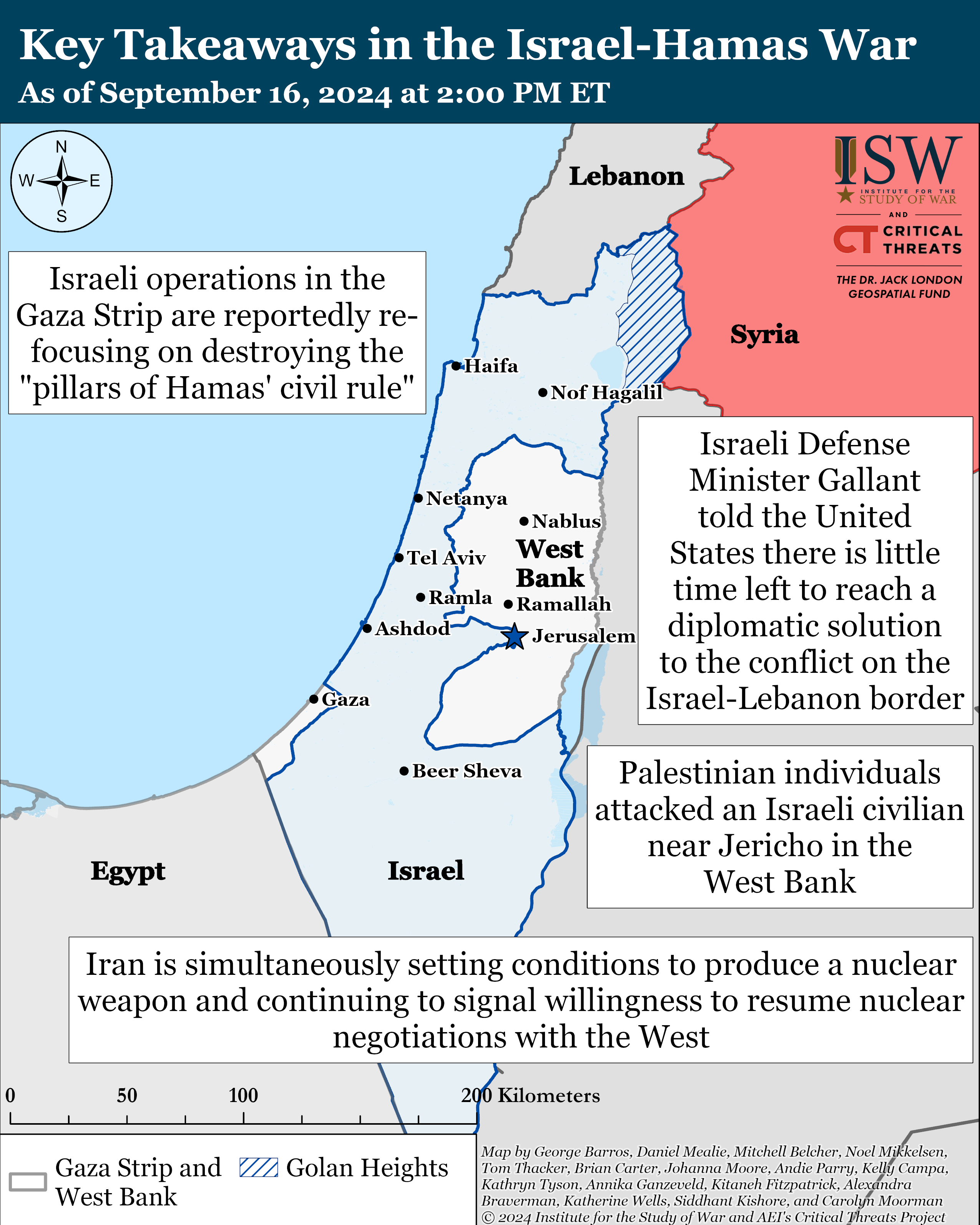 Institute for Study of War Backgrounder 16 September Gaza Israel is refocusing its operations in the Gaza Strip to prioritize “destroying the pillars of Hamas’ civil rule . . . especially the distribution of humanitarian aid,” according to an anonymous Israeli official. The official told Israeli media that controlling aid distribution enables Hamas to project the image that it still controls the Gazan population. The IDF continued operations around the Netzarim Corridor, south of Gaza City, on September 16. A Palestinian journalist reported small arms fire and shelling in Tal al Hawa and Sheikh Ijlin, southern Gaza City and said Israeli forces were near Kuwait Circle in Zaytoun. The IDF also announced that its 5th (Res.) Brigade began operations in the Gaza Strip under the command of the IDF 252nd Division, which has been deployed around the Netzarim Corridor since July 27. The 5th Brigade last operated in the Gaza Strip in early February 2024. The IDF said three Israeli hostages were likely killed as a “byproduct” of an Israeli airstrike in the Gaza Strip on November 10. The IDF conducted an airstrike targeting the commander of Hamas’ Northern Gaza Brigade in Jabalia. Hamas Political Bureau member and spokesperson Osama Hamdan said on September 16 that Hamas officials and representatives from Palestinian factions will soon meet in Cairo to discuss Palestinian visions for post-war governance. Hamas leader Yahya Sinwar sent a letter to Houthi leader Abdulmalik al Houthi, according to Houthi media on September 15, emphasizing that the Hamas is “well” and calling Israeli announcements claiming the opposite “psychological warfare.” West Bank Israeli forces engaged Palestinian fighters in at least three locations in Nablus since CTP-ISW's last data cutoff on September 15. Hamas and the al Aqsa Martyrs’ Brigades separately fired small arms and detonated improvised explosive devices (IED) targeting Israeli forces in the Balata refugee camp. Lebanon Hezbollah has conducted 10 attacks into northern Israel since CTP-ISW's last data cutoff on September 15. A senior US official discussed the security situation along the Israel-Lebanon border with Israeli Prime Minister Benjamin Netanyahu and Defense Minister Yoav Gallant in separate meetings on September 15 and 16. Netanyahu told US Presidential Envoy Amos Hochstein during a meeting in Tel Aviv that Israel cannot return displaced Israeli residents to northern Israel ”without a fundamental change in the security situation” there. Axis of Resistance Iranian-backed Iraqi fighters likely conducted a drone attack targeting US forces at the Rumalyn Landing Zone in Hasakah Province, Syria. Sources claimed that US air defenses intercepted three drones launched from Syrian regime-controlled territory in Deir ez Zor Province. An Iranian-backed militia drone attack injured eight US service members at Rumalyn Landing Zone in August 2024. Houthi spokesperson Yahya Sarea released footage of the ballistic missile that the Houthis fired into Israel. The Houthis claimed that the attack targeted an unspecified military target around Tel Aviv with a “new hypersonic missile.” The Houthis claimed that they intercepted a US MQ-9 drone over Dhamar Governorate, Yemen, on September 15. Houthi spokesperson Yahya Sarea said the Houthis have intercepted three total MQ-9s this week and ten MQ-9s since the start of the Israel-Hamas war in October 2023. US Central Command (CENTCOM) destroyed a missile system in Houthi-controlled Yemen on September 15. View Quote 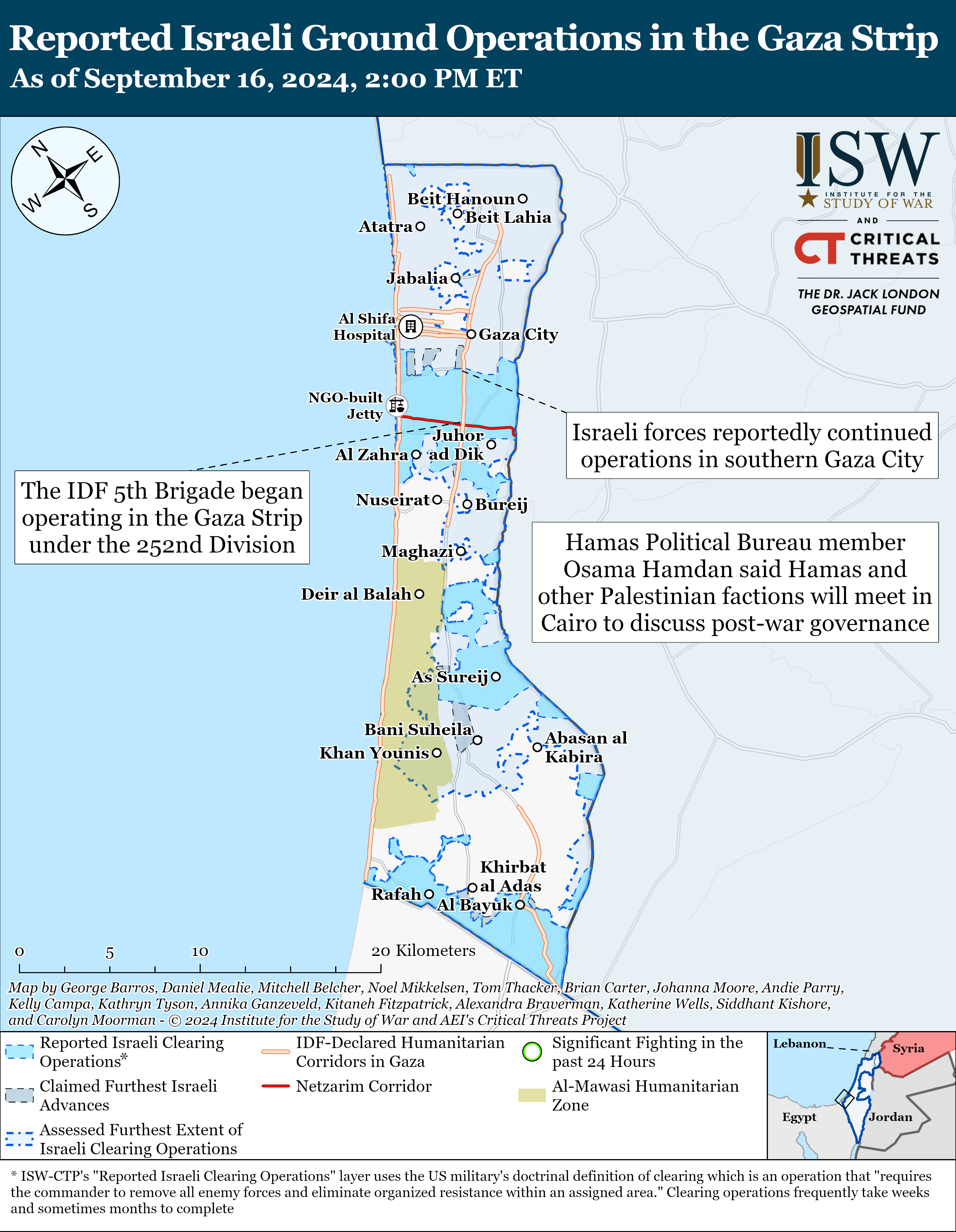 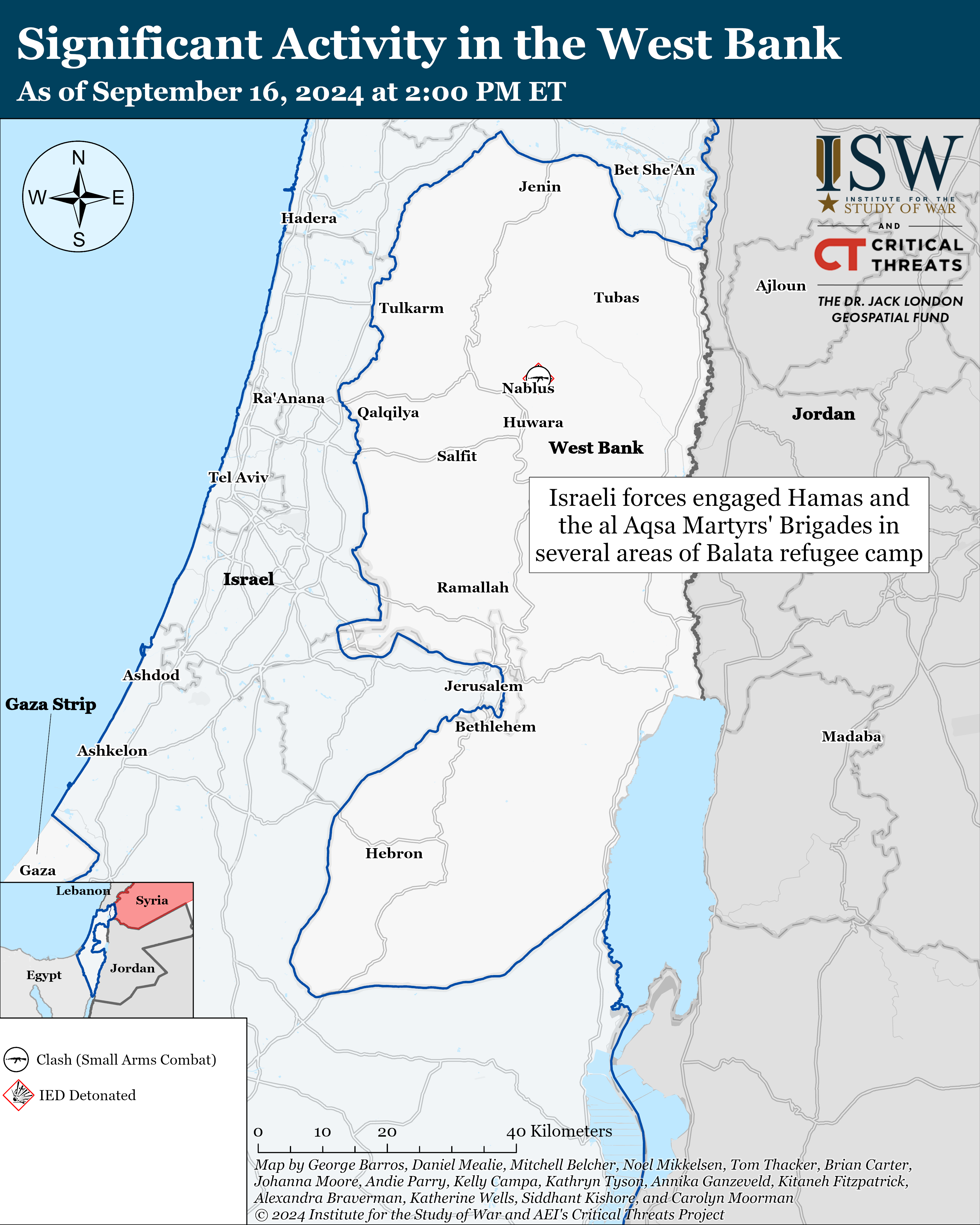 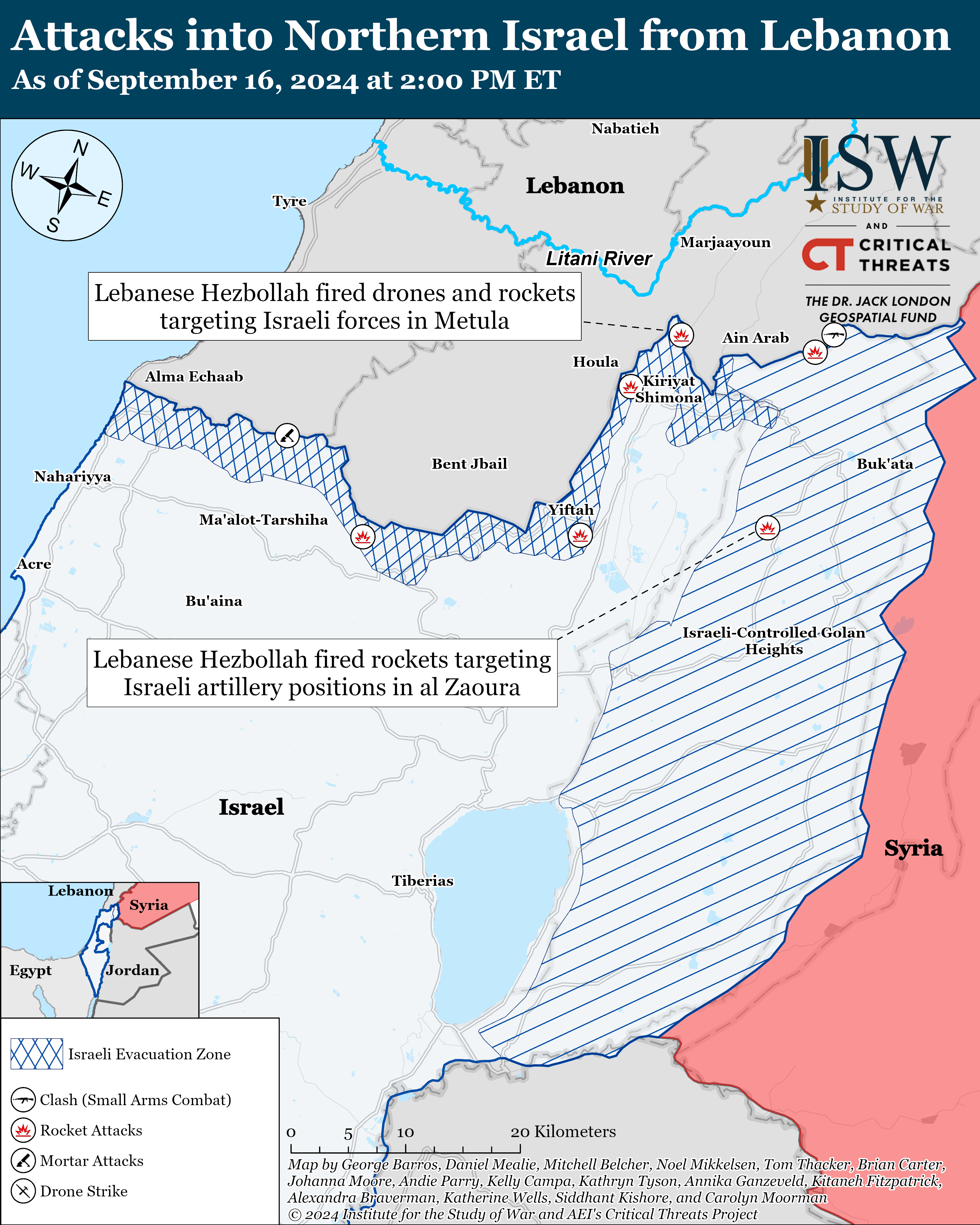
|
|
|
"A dying culture invariably exhibits personal rudeness. Bad manners. Lack of consideration for others in minor matters. A loss of politeness, of gentle manners, is more significant than is a riot."
Robert A. Heinlein, Friday |
Lebanese media report that there are dozens of injuries after portable pagers used by Hezbollah operatives exploded. The communication devices detonated allegedly after being hacked by Israel. According to Lebanese media, dozens of injuries are reported in the Beirut suburb of Dahieh, as well as several other regions of Lebanon. View Quote
X post for pictures below. Won't let me post the normal way. |
|
|
"A dying culture invariably exhibits personal rudeness. Bad manners. Lack of consideration for others in minor matters. A loss of politeness, of gentle manners, is more significant than is a riot."
Robert A. Heinlein, Friday |
|
Originally Posted By michigan66:
https://www.ar15.com/media/mediaFiles/501718/IMG_2348_jpeg-3324743.JPG https://www.ar15.com/media/mediaFiles/501718/IMG_2349_jpeg-3324744.JPGhttps://www.ar15.com/media/mediaFiles/501718/IMG_2351_jpeg-3324745.JPGhttps://www.ar15.com/media/mediaFiles/501718/IMG_2350_jpeg-3324746.JPG View Quote You should make this its own thread, most people won't see it here. |
|
|
|
|
Holy shit. So they figured out how to make these things explode remotely (presumably using the battery as the explosive)? Or they seeded their equipment with a bunch of eldest son pagers and then sent the detonation command?
Saying they were "hacked" implies the former, which is a rather terrifying prospect. |
|
|
|
|
Originally Posted By CMiller: You should make this its own thread, most people won't see it here. View Quote View All Quotes View All Quotes Originally Posted By CMiller: You should make this its own thread, most people won't see it here. I was behind the curve, the guys in the Russia/Iran/China thread beat me to it. It found its way to GD at any rate. Originally Posted By LoBrau: Holy shit. So they figured out how to make these things explode remotely (presumably using the battery as the explosive)? Or they seeded their equipment with a bunch of eldest son pagers and then sent the detonation command? Saying they were "hacked" implies the former, which is a rather terrifying prospect. Who knows, seems a bit far fetched to give them hundreds of phones with explosives--if you can do that, why not bug them instead? If that's the case, I'd hate to be the Hezbollah version of Bernard right now.  The Wire - Lester does business with Bernard |
|
|
"A dying culture invariably exhibits personal rudeness. Bad manners. Lack of consideration for others in minor matters. A loss of politeness, of gentle manners, is more significant than is a riot."
Robert A. Heinlein, Friday |
|
Graphic X video of injuries. Might not work if you're not signed in.
EXTREMELY GRAPHIC: The injured and dead in a Lebanese hospital. This has to be one of Hezbollah's worst days since the 1980s when it was established. View Quote Screenshots in spoiler Click To View Spoiler |
|
|
"A dying culture invariably exhibits personal rudeness. Bad manners. Lack of consideration for others in minor matters. A loss of politeness, of gentle manners, is more significant than is a riot."
Robert A. Heinlein, Friday |
|
Link to liveblog articles below.
Electronic pager devices also exploded in Syria, according to Iran’s Tasnim news agency and to Saberin News, an outlet affiliated with the Revolutionary Guards. Saberin reported that seven people were killed in Syria from the blast targeting their devices in the Seyedah Zeinab neighborhood, a Shia stronghold in Damascus. View Quote Lebanon's health minister, Dr. Firass Abiad, said in a news conference that eight people were killed by exploding paging devices and about 2,780 were wounded, including approximately 200 in serious condition. Dr. Abiad also said many of the victims had injuries to their faces, particularly the eyes, as well as to their hands and stomachs. One of those killed was an 8-year-old girl, he said. View Quote Large numbers of “wireless devices” simultaneously exploded across Lebanon in an apparently coordinated attack that caused hundreds of injuries, Lebanese health officials said on Tuesday, a day after Israeli leaders warned that they were considering stepping up their military campaign against Hezbollah. Hezbollah said that pagers belonging to its members had exploded, but that the cause was being investigated. Three people, including a child, were killed, according to the statement, which did not assign blame for the blasts. Lebanon’s health minister, Firass Abiad, said that hundreds of people had been injured. The Israeli military declined to comment. Three officials briefed on the attack said that it had targeted hundreds of pagers belonging to Hezbollah operatives who have used such devices for years to make it harder for their messages to be intercepted. The devices were programmed to beep for several seconds before exploding, according to the officials, who spoke on the condition of anonymity because of the sensitivity of the matter. Lebanon’s Health Ministry said in a statement that many people had arrived at Lebanese hospitals after being wounded when their wireless devices exploded. The ministry warned citizens to stay away from similar devices until it was clear what had caused the blasts. The Lebanese Red Cross said that dozens of ambulances were responding to “multiple bombings” in southern and eastern Lebanon, as well as in Beirut, the capital, and Lebanon’s Internal Security Forces Directorate asked people to clear the roads so people could be rushed to hospitals. The blasts appeared to be the latest salvo in an 11-month conflict between Israel and Hezbollah that began last October, after Hezbollah began firing into Israeli territory in solidarity with its ally, Hamas. The conflict has largely remained contained to exchanges of missiles and rockets, but for months, leaders on either side have warned that it could expand into a war involving ground forces. View Quote Iran’s ambassador to Lebanon, Mojtaba Amani, was one of the hundreds of people injured in a wave of blasts targeting electronic devices in Lebanon, the Mehr News agency reported. Iran appoints ambassadors to Lebanon and other key allied countries in the region from the senior ranks of Revolutionary Guards Corps, and they play a key role in supporting militia groups supported by Iran, such as Hezbollah in Lebanon. Iranian media said the ambassador was using one of the pagers apparently used in the attack, and two of his bodyguards were also injured. A post from Iran’s Embassy in Lebanon said Amani’s injuries were not serious. View Quote |
|
|
"A dying culture invariably exhibits personal rudeness. Bad manners. Lack of consideration for others in minor matters. A loss of politeness, of gentle manners, is more significant than is a riot."
Robert A. Heinlein, Friday |
|
Mossad>CIA
|
|
|
|
One wonders what other folk were injured, such as Hezbollah-linked “journalists” or members of NGOs who have ties to the group…if Hezbollah is anything like Hamas it will have its members infiltrating many organizations. It would be embarrassing if employees of the UN or workers at a UN facility had pagers linked to this…I guess time will tell View Quote X thread
Because people are hitting me up about this left and right. Here is how it works: 1. Technicians buy three of the item, one gets taken all the way down, one stays in the box, the third one they fuck with. 2. On the device taken all the way down, the techs look at the parts. 3. Identify a part that can be slightly enlarged without anyone noticing. 4. 3D print that exact part of the device but just slightly larger to create a gap in the fuel cell, etc. 5. That gap is the room you get the play in. Insert listening devices, trackers, or demo. 6. Now you need to get it into the bad guy's hands. This is done using corporate front companies & unwitting weak links in the bad guy's supply chain. 7. Even underground groups get lazy & choose the path of least resistance. Not uncommon for them to buy in bulk from one place. 8. If possible, you use a recruited asset in the organization to guide them towards the poisoned link in the supply chain, could be a cell phone kiosk, electronics store, or Internet cafe (in the day). 9. Then kaboom. But the amount of demo appears to be non-lethal, so is this just a psyop? A warning? Or just a high end piece of performance art orchestrated by the Israeli intelligence community? For an op like this to be effective, you use it to shape the battle space and follow with strategic strikes. All of the guys centralizing themselves at ERs after the boom, for example. Failing that, you kind of wonder what the point is. That's a lot of resources to put into a op just warning hez that they can be killed at any time, which they already know. Of course it could be simply a way to engineer new comms patterns in the organization, I don't really know. View Quote |
|
|
"A dying culture invariably exhibits personal rudeness. Bad manners. Lack of consideration for others in minor matters. A loss of politeness, of gentle manners, is more significant than is a riot."
Robert A. Heinlein, Friday |
|
I am back in the US but I just got off the phone with some people in the north. Everyone is hunkered down hard and being told to do so.
There is a belief that an attack may come or Israel may use this moment to launch a significant attack. |
|
|
|
|
Originally Posted By neshomamench: I am back in the US but I just got off the phone with some people in the north. Everyone is hunkered down hard and being told to do so. There is a belief that an attack may come or Israel may use this moment to launch a significant attack. View Quote Glad you're back. It would be a great time for Israel to hit them. |
|
|
"A dying culture invariably exhibits personal rudeness. Bad manners. Lack of consideration for others in minor matters. A loss of politeness, of gentle manners, is more significant than is a riot."
Robert A. Heinlein, Friday |
|
This is a big fucking deal. And just because Israel hasn't explicitly capitalized on it yet didn't mean they won't at any moment.
|
|
|
|
|
Originally Posted By LoBrau: Holy shit. So they figured out how to make these things explode remotely (presumably using the battery as the explosive)? Or they seeded their equipment with a bunch of eldest son pagers and then sent the detonation command? Saying they were "hacked" implies the former, which is a rather terrifying prospect. View Quote That is serious next level $h!t right there. Imagine if same could be done with phones..... |
|
|
|
|
Originally Posted By michigan66: I was behind the curve, the guys in the Russia/Iran/China thread beat me to it. It found its way to GD at any rate. Who knows, seems a bit far fetched to give them hundreds of phones with explosives--if you can do that, why not bug them instead? If that's the case, I'd hate to be the Hezbollah version of Bernard right now. View Quote Thanks. Now I have to watch The Wire again. This attack was brilliant. Presumably a literal, physical supply chain attack? |
|
|
“...in the hands of politicians grand designs achieve nothing but new forms of the old misery...”
|
|
Hezbollah started using paging devices more widely after Oct. 7, experts say. Link
Senior members of Hezbollah have used pagers for years but the practice became more widespread after the Oct. 7 attacks, when the group’s leader warned members that Israeli intelligence had penetrated the cellphone network, security experts said Tuesday. As a result, thousands of rank-and-file members of Hezbollah — and not just fighters — switched to a new system of wireless paging devices, said Amer Al Sabaileh, a regional security expert and university professor based in Amman, Jordan. He said his information was based on extensive contacts in Lebanese political and security circles. It was not immediately clear how those devices were distributed, but large numbers of pagers exploded at approximately the same time on Tuesday in Lebanon, causing thousands of injuries, according to Lebanese health authorities. Since the advent of cellphones and smartphones, pagers have fallen out of use, though they remain in use by some people for quick and private contact. Hezbollah has been security conscious about telecommunications for years, Mr. Al Sabaileh said, and has long banned its operatives from using cellphones while they are traveling in the south of the country near the Israel border. Cellphones can be used to locate the person carrying them. But, he said, that became more urgent after Oct. 7, when some of the Hezbollah’s senior members were assassinated in airstrikes. In February, Hezbollah’s chief, Hassan Nasrallah, warned members during a speech that their phones were dangerous and could be spied on by Israeli forces, saying they should break or bury them. Iran, whose government has for decades supplied Hezbollah with arms, technology and other forms of military aid, and would have been pivotal both to any decision to switch to the system and in the delivery of the technology, the experts said. Experts said that they did not know the precise arrangement for the distribution of the paging devices to Hezbollah members, nor how they had been compromised, but a key element of the new paging system was that it did not use the network of satellites that are the basis of most conventional cellphone networks, and therefore were harder to track electronically. David Wood, a senior Lebanon analyst with the International Crisis Group think tank, described it as a “limited, closed network.” He said that in the short term, Hezbollah would likely resort to other methods of communication, potentially one that avoided electronic means altogether. “It will obviously make coordination more difficult and more risky and without a doubt this is a serious blow to Hezbollah’s operational capacity,” he said. Mr. Sabaileh said the explosions would be a psychological blow for Hezbollah because it showed the capacity of Israel to strike not just fighters but anyone connected with the group as they went about their daily business. “It’s like doing an operation in every part of Hezbollah’s territory,” Mr. Sabaileh said, adding that the group would likely see it as a prelude to an Israeli escalation of the conflict, potentially on the ground. “The way they are targeted and the timing looks like a movie — making devices explode all at the same time everywhere is shocking.” View Quote |
|
|
"A dying culture invariably exhibits personal rudeness. Bad manners. Lack of consideration for others in minor matters. A loss of politeness, of gentle manners, is more significant than is a riot."
Robert A. Heinlein, Friday |
A Lebanese security source tells Al Jazeera that the Hezbollah pagers that exploded earlier today were imported to Lebanon five months ago. The report says that the communication devices were rigged with up to 20 grams of explosive material. A separate report by the UAE-based Sky News Arabia claims that the Mossad placed PETN, a powerful explosive material, on the batteries of the pagers and detonated them by raising the temperature. View Quote
Hezbollah’s worst nightmare: Chaos in its ranks Hezbollah is known as a disciplined group. Highly trained, the group invests heavily in its recruits. It is not known to waste them as cannon fodder. It views itself as an elite organization, and within its own structure, there are centers of terrorist excellence, such as the Radwan force. Hezbollah has achieved this through decades of fine-tuning its capabilities. It has built itself up slowly, first in the 1980s and then in the last two decades as it came to dominate Lebanon. Now, the group faces its worst nightmare: Chaos. Hezbollah is facing chaos because a large number of its alleged members were wounded on September 17 by exploding communications devices. The full details of this incident are not yet known, and they will only be known over time. However, video and images from Lebanon show men, many of them in their forties, wounded in the hands and faces by exploding communications devices. The devices are alleged to be pagers. The video shows at least one man pulling his pager from his pocket, only to have it explode in his hand. Gruesome videos, apparently from hospitals in Lebanon, show a large number of men missing parts of their hands or wounded in the legs, stomach, or face. Suffering so many casualties to key members of the terrorist group may not be crippling, but it clearly will harm a swatch of the group’s key members. This will put the men in hospital for a period of time. Some of them can go back to serving Hezbollah, but they will not have access to one of their hands. These will most likely be their dominant hand, meaning the hand they’d also use to hold the trigger of a rifle or push the button to launch a missile. The men will also be marked going forward, so many men with bandages on their hands will be a mark of working for the terrorist group. Hezbollah has already lost around 450 fighters in its eleven-month confrontation with Israel. This is a significant loss for the group. While Hezbollah can replace losses, it doesn’t have an endlessly deep batting order. This is not only because it has to invest in training and security ahead of recruitment, but it also draws its recruits from a narrow spectrum of Lebanese society. Hezbollah is based on the Shi’ite population of Lebanon, and even among Shi’ites, it can’t recruit all of them. There are other Shi’ite movements, principally the Amal movement. Amal has 14 seats in Lebanon’s parliament, and Hezbollah has 15. The overall challenge for Hezbollah is not just replacing wounded and dead fighters. The group will be challenged to rapidly roll out some other way to communicate with its men. The use of pagers may seem archaic, but Hezbollah apparently chose to use this system because it assumed the network could not be penetrated. It issued the pagers, the way a drug gang might do so, and secured the network itself. Hezbollah has long sought to maintain its own complex and secure communications network in Lebanon. Back in 2008, this became controversial. Hezbollah was accused of killing former Lebanese Prime Minister Rafic Hariri and then dragging Lebanon into the 2006 war with Israel. View Quote
Remarkable… A Reuters story from July details how Hezbollah, in the aftermath of Israel killing one of its top commanders, shifted even further away from cell phone communication. Hezbollah, Reuters reported at the time, was opting to go with the low-tech route of…pagers. View Quote
FDD Analysis here. Latest Developments Hundreds of Hezbollah operatives were wounded in various parts of Lebanon on September 17 when the pagers they use to communicate exploded, in what appeared to be an act of long-range sabotage. Lebanon’s Health Ministry said that at least 2,800 were injured, some of them seriously. The casualties — which also included some fatalities — were the result of what a Hezbollah official quoted by Reuters described as the “biggest security breach” suffered by the Iranian-backed terrorist group during the almost year-old war with Israel. Another Hezbollah official blamed the explosions on Israel, telling the Associated Press that “the enemy stands behind this security incident.” The same official said that Hezbollah terrorists had recently been issued with new pagers containing lithium batteries that were apparently the source of the blasts. Among those who sustained minor injuries was the Iranian Ambassador to Beirut, Mojtaba Amani, along with two of his bodyguards. Similar explosions were also reported in neighboring Syria, with Iranian state media outlets claiming that seven people were killed from blasts targeting their devices in the Seyedah Zeinab neighborhood, a Shia stronghold in Damascus, according to The New York Times. Israel offered no comment in the immediate aftermath of the explosions. In recent weeks, Jerusalem has warned that it is prepared to escalate clashes with Hezbollah to end the cross-border attacks that have displaced more than 60,000 Israelis from their homes. Hezbollah launched the attacks in earnest following the October 7 Hamas atrocities in the south of Israel. On September 16, both Israeli Defense Minister Yoav Gallant and Israel Defense Forces (IDF) Maj. Gen. Ori Gordin, the head of the Northern Command, said that an expanded military operation was increasingly becoming necessary to restore stability to the area. Israel’s security cabinet also announced that the goals of the war had been updated to include safely returning displaced Israelis to the north. “Israel will continue to act to implement this objective,” a statement from the prime minister’s office declared. Expert Analysis “This was an extraordinary example of technological and intelligence penetration. We do not yet know the extent of the damage and whether this was cover for an even deeper penetration. Hezbollah will have to recall all of its communications devices to assess the extent to which these have been compromised. That will hinder its operational capacity — as will having so many men incapacitated, even if temporarily.” — Mark Dubowitz, FDD CEO “Today’s incident demonstrates, once again, the extent to which Israeli intelligence has succeeded in penetrating Hezbollah’s organizational apparatus. Much remains unclear about the outcome of the attack, including the identity of the casualties — but many of the wounded Hezbollah operatives are also unlikely to return to battle.” – David Daoud, FDD Senior Fellow Israel Foils Hezbollah Plot to Assassinate Top Security Official The explosions in Lebanon were reported just hours after Israel’s Shin Bet intelligence agency revealed that a Hezbollah plot to assassinate a former senior Israeli security official with an anti-personnel mine had been foiled. The announcement, which did not name the targeted individual, followed threats by the Lebanese terrorist group to avenge the Israeli airstrike that killed its top commander, Fuad Shukr, in Beirut on July 30. According to the Shin Bet, the assassination had been imminent, with Hezbollah planning to use a Claymore-style mine with a cellphone detonator and camera remote-operated from Lebanon. View Quote |
|
|
"A dying culture invariably exhibits personal rudeness. Bad manners. Lack of consideration for others in minor matters. A loss of politeness, of gentle manners, is more significant than is a riot."
Robert A. Heinlein, Friday |
|
"A dying culture invariably exhibits personal rudeness. Bad manners. Lack of consideration for others in minor matters. A loss of politeness, of gentle manners, is more significant than is a riot."
Robert A. Heinlein, Friday |
 Win a FREE Membership!
Win a FREE Membership!
Sign up for the ARFCOM weekly newsletter and be entered to win a free ARFCOM membership. One new winner* is announced every week!
You will receive an email every Friday morning featuring the latest chatter from the hottest topics, breaking news surrounding legislation, as well as exclusive deals only available to ARFCOM email subscribers.
AR15.COM is the world's largest firearm community and is a gathering place for firearm enthusiasts of all types.
From hunters and military members, to competition shooters and general firearm enthusiasts, we welcome anyone who values and respects the way of the firearm.
Subscribe to our monthly Newsletter to receive firearm news, product discounts from your favorite Industry Partners, and more.
Copyright © 1996-2024 AR15.COM LLC. All Rights Reserved.
Any use of this content without express written consent is prohibited.
AR15.Com reserves the right to overwrite or replace any affiliate, commercial, or monetizable links, posted by users, with our own.

